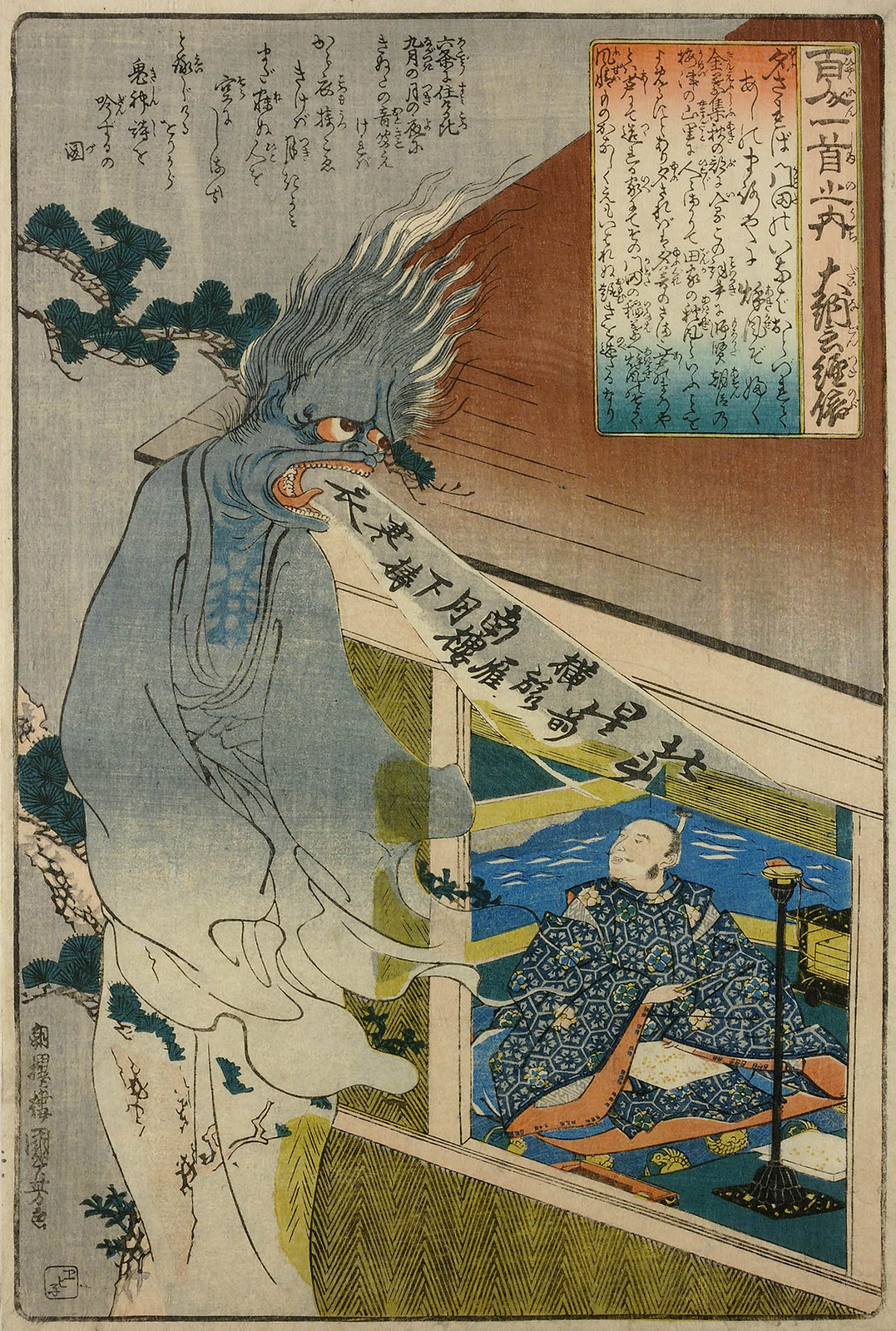 The Poet Dainagon Sees an Apparition, 1860
The Poet Dainagon Sees an Apparition, 1860This week is the ten year anniversary for Monster Brains, I've chosen to share a wide assortment of Kuniyoshi's incredible work to mark the occasion. Over the years Monster Brains has grown from a simple collection of links to a vast resource onto itself. This is due, in part, to my obsessive nature in collecting the artwork that I'm passionate about for myself but also my commitment to sharing this work with others that will appreciate it as well.
That said, I make my living as an artist and it has been growing more difficult to take the time away from my work to research and prepare posts for the site. You would probably be shocked to know the amount of time that I invest into many of the posts on Monster Brains. I've resisted putting advertisements on the site to take on additional revenue but recently I have placed a donation button on the site. If you appreciate Monster Brains and the work put into the thousands of artworks that I've shared over the past ten years, if you anticipate the hundreds of future posts that I have in various stages of planning, please donate whatever you can, it will be greatly appreciated.
The donation button can be found on the top right of Monster Brains.
Thank you! I look forward to many more years of discovering and sharing the more obscure and fascinating artists associated with the genre of monsters.
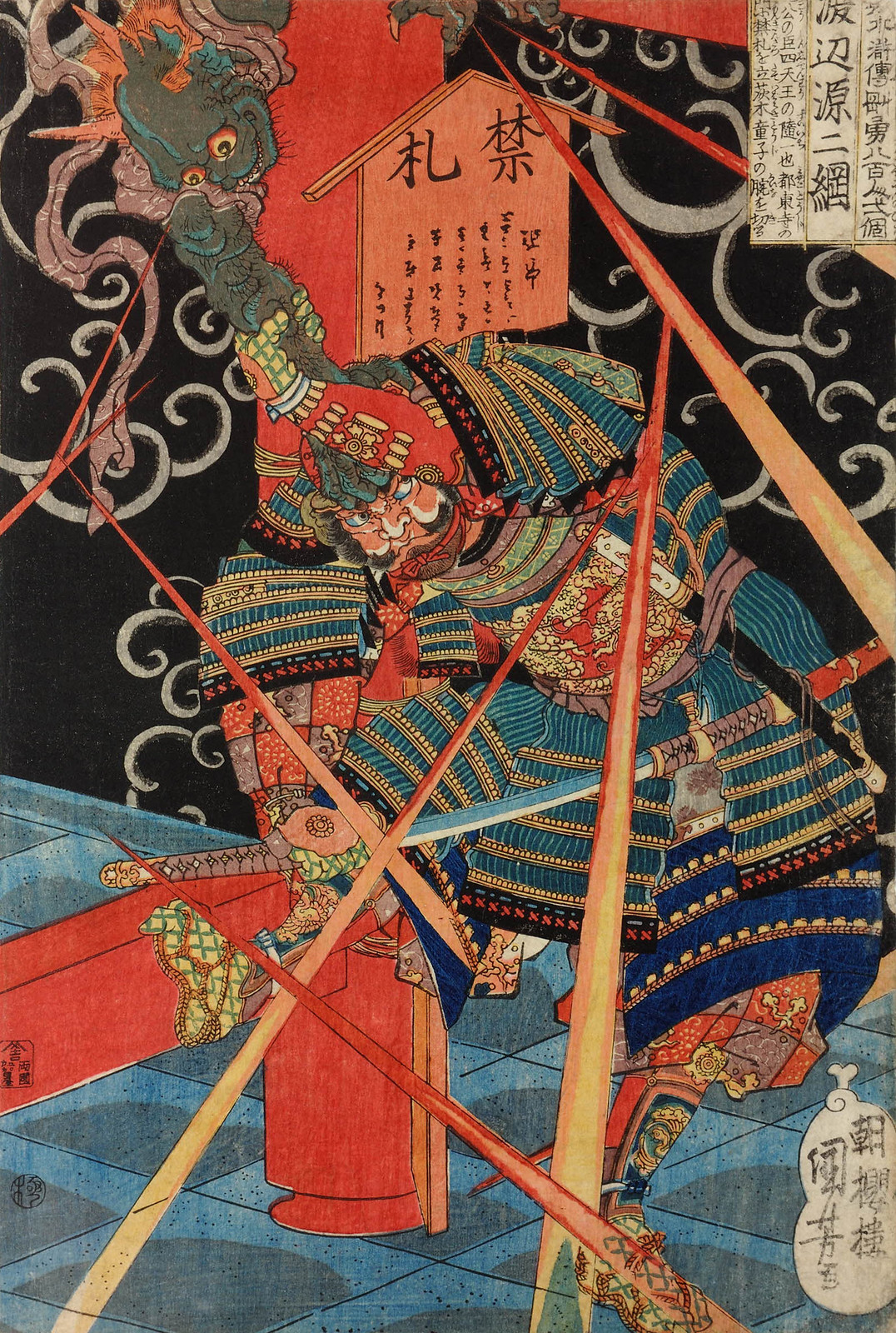 Takiguchi U-Toneri Watanabe no Tsuna about to cut off the arm of Rashomon, who grasps his hair. Edo Period
Takiguchi U-Toneri Watanabe no Tsuna about to cut off the arm of Rashomon, who grasps his hair. Edo Period 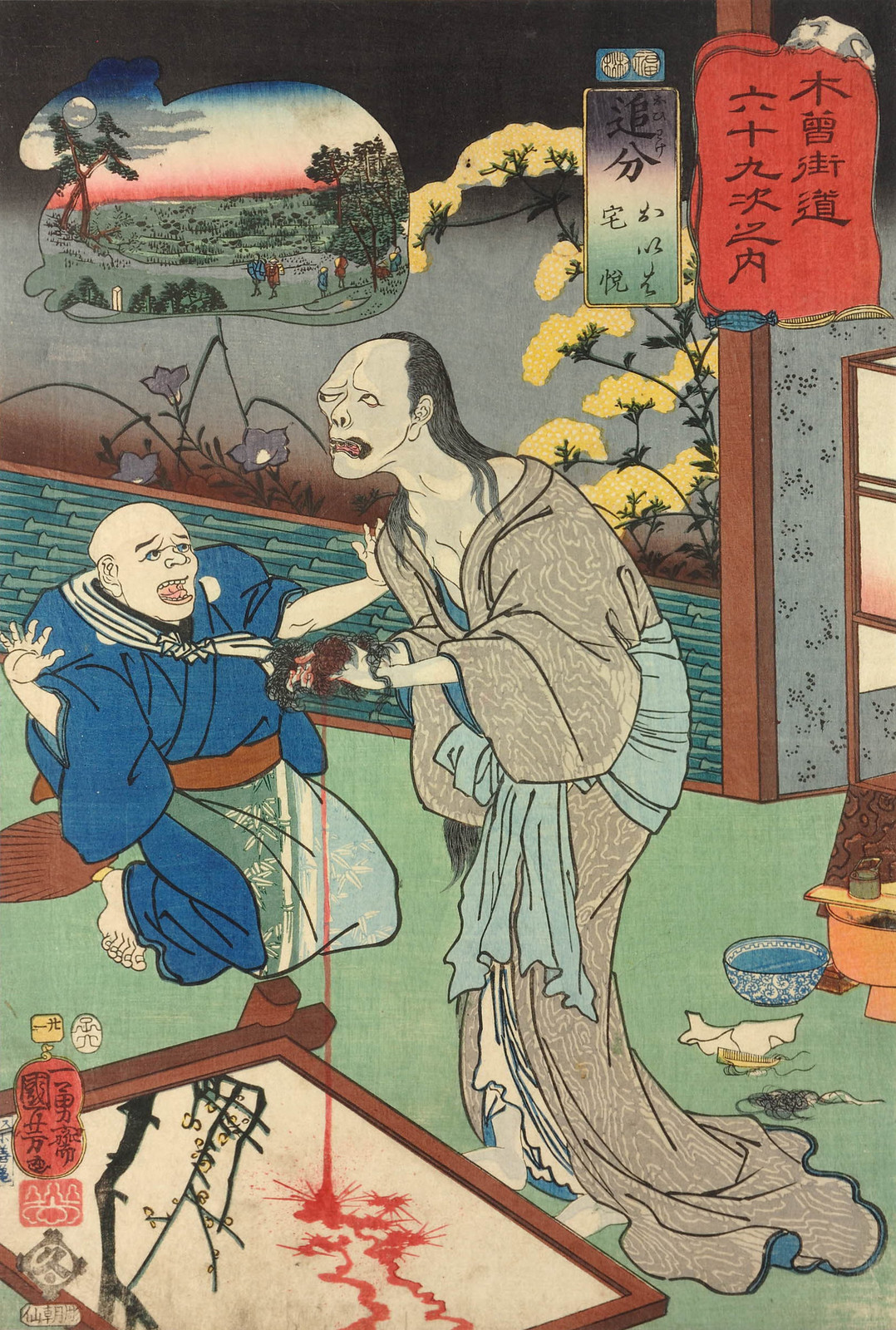 Oiwake- Oiwa and Takuetsu, from the series Sixty-nine Stations of the
Kisokaidô Road (Kisokaidô rokujûkyû tsugi no uchi) 1852
Oiwake- Oiwa and Takuetsu, from the series Sixty-nine Stations of the
Kisokaidô Road (Kisokaidô rokujûkyû tsugi no uchi) 1852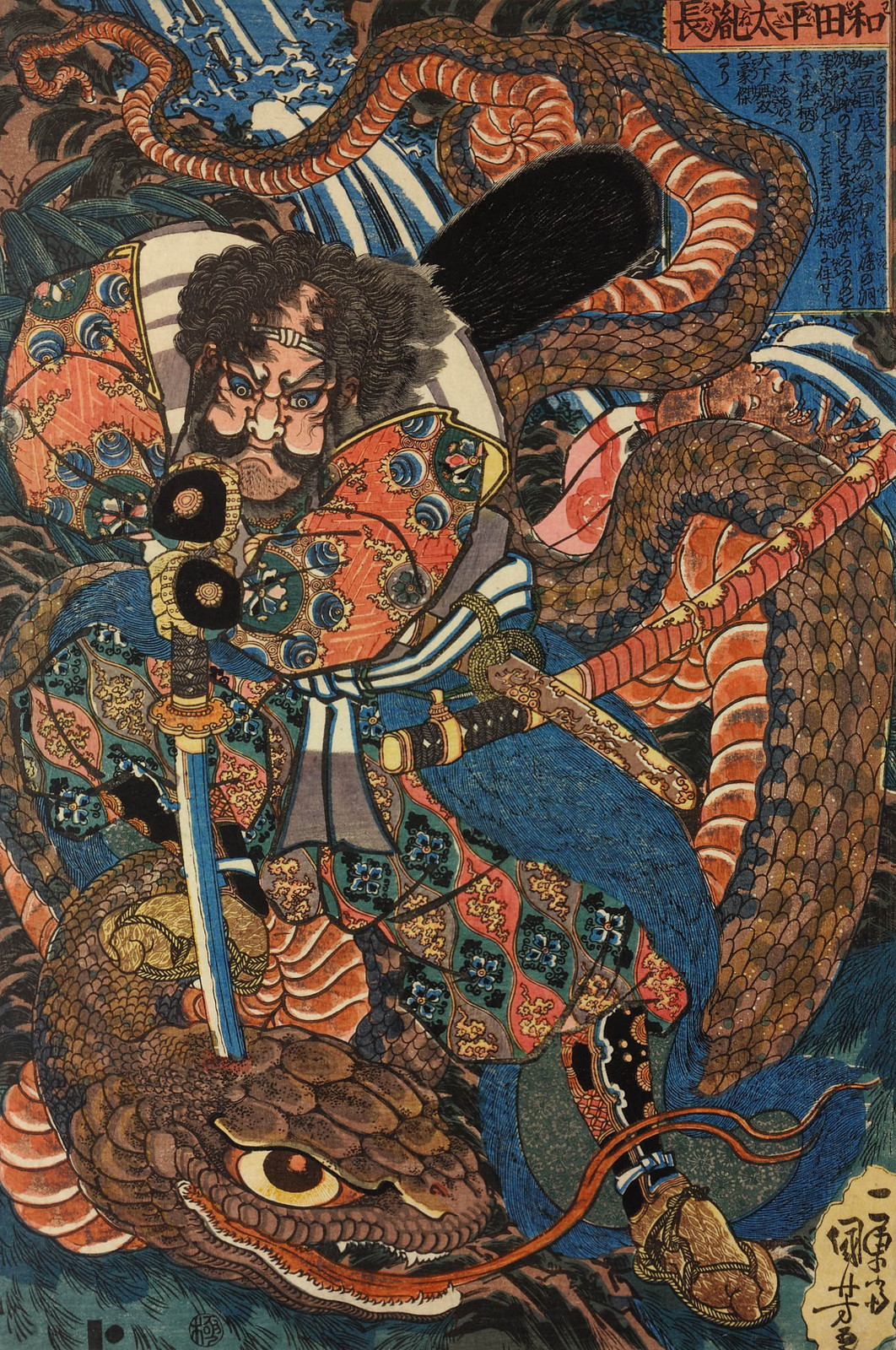 Wada Heita Tanenaga killing a huge python by driving his sword into the back of its head by a waterfall. Edo Period
Wada Heita Tanenaga killing a huge python by driving his sword into the back of its head by a waterfall. Edo Period 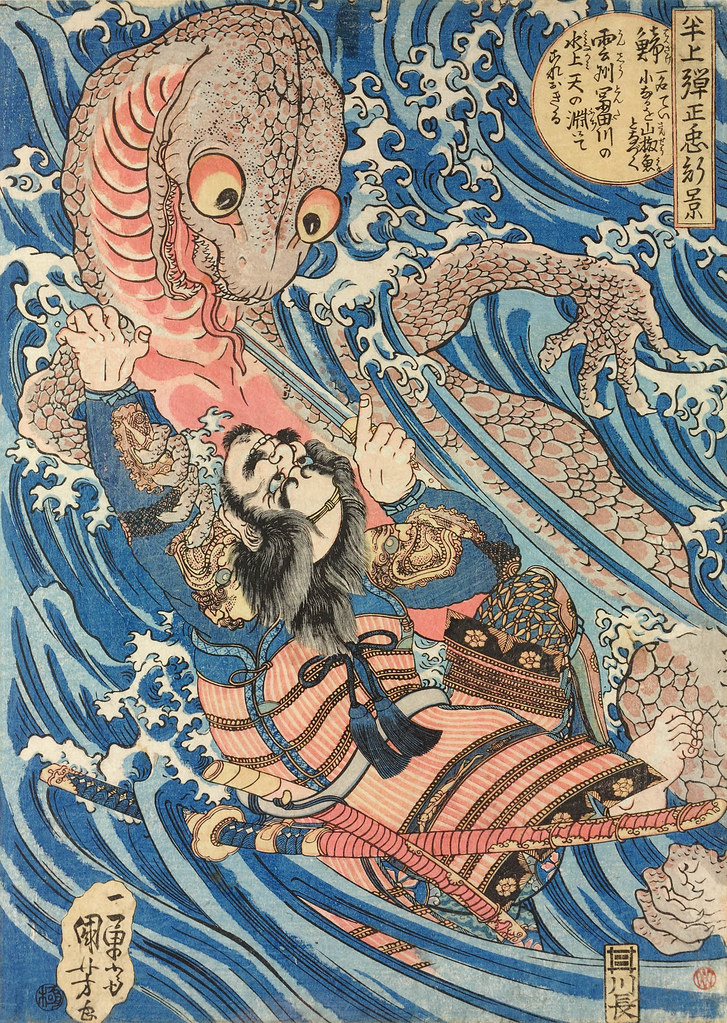 Hangami Danjo-no-jo Arakage killing a giant salamander in the Tontagawa river in the province of Izumo, Edo Period
Hangami Danjo-no-jo Arakage killing a giant salamander in the Tontagawa river in the province of Izumo, Edo Period  Tsuzoku Suikoden Goketsu Hyakuhachi-nin no Hitori, Ju-unryu Kosonsho, a sorcerer, evoking a storm-dragon. 1827
Tsuzoku Suikoden Goketsu Hyakuhachi-nin no Hitori, Ju-unryu Kosonsho, a sorcerer, evoking a storm-dragon. 1827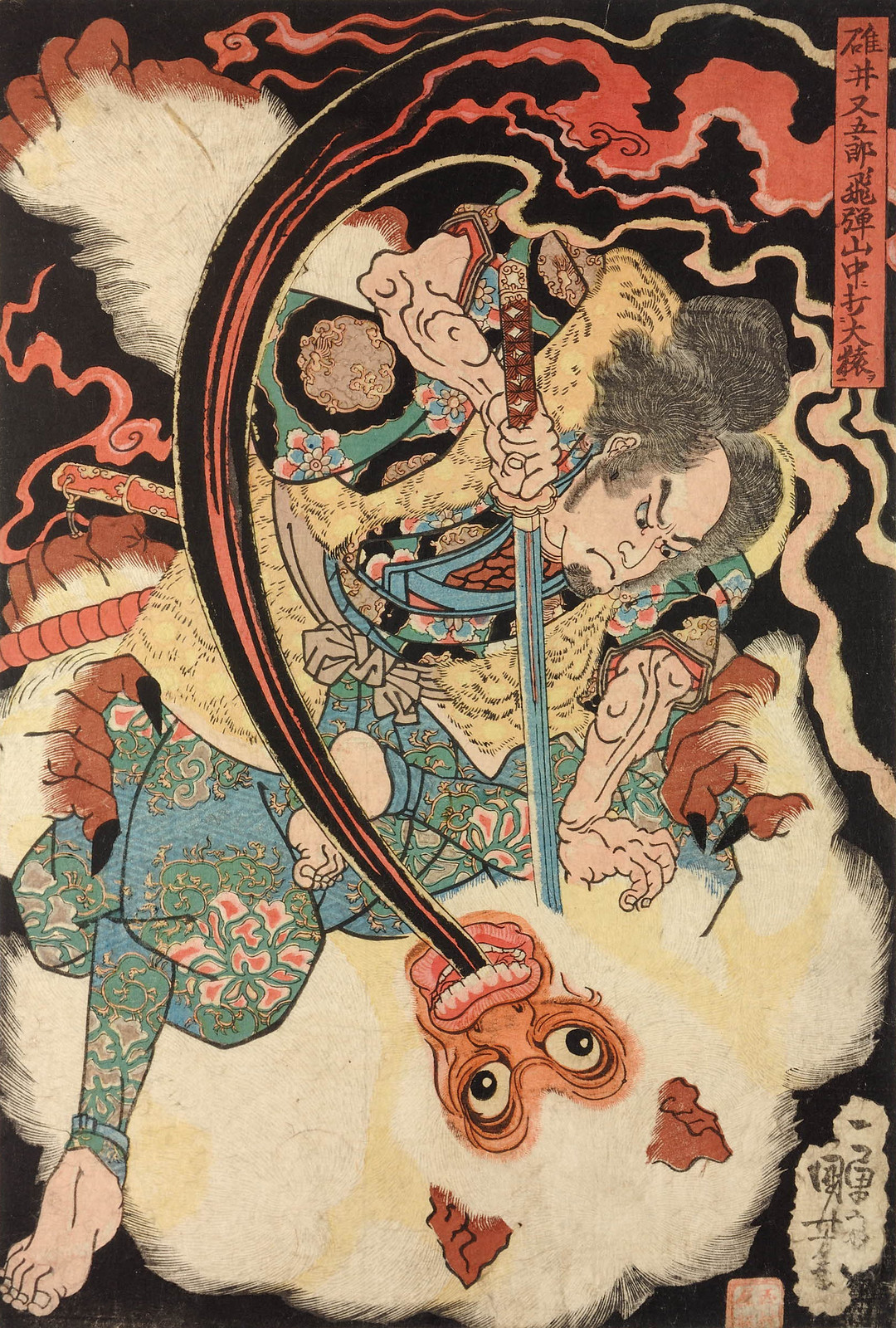 Usui Matagoro slays a giant white monkey in the mountains of Hida, a
long stream of black smoke curling up from the monster's mouth,
Edo Period
Usui Matagoro slays a giant white monkey in the mountains of Hida, a
long stream of black smoke curling up from the monster's mouth,
Edo Period 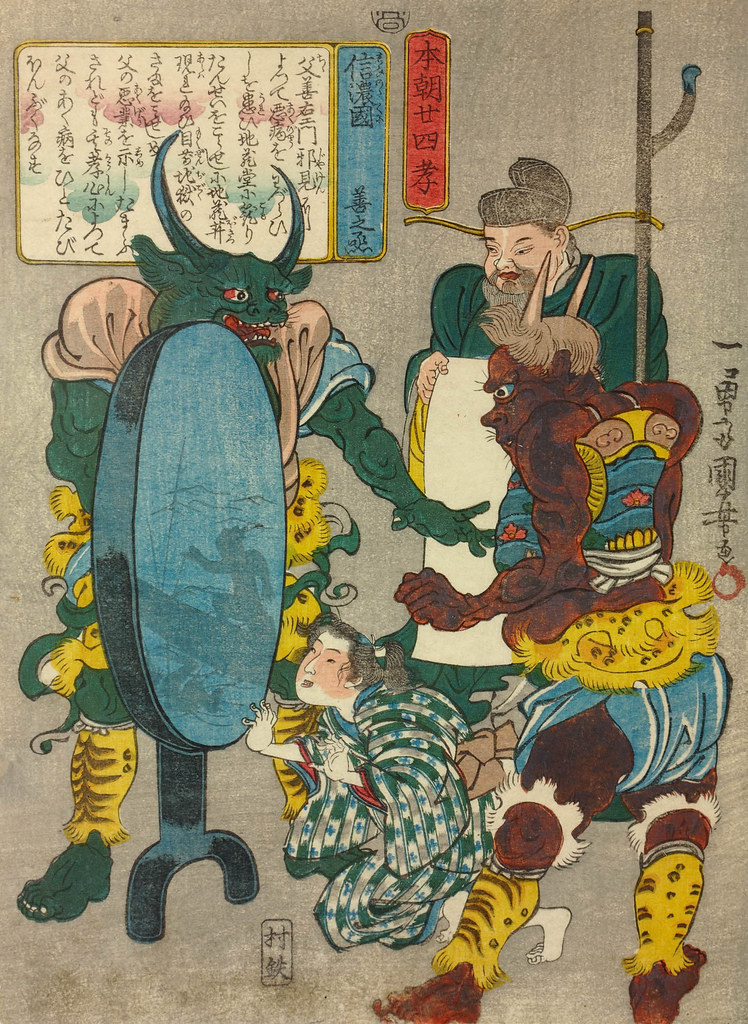 Shinano kuni no Zen-no-jo (Zen-no-jo of Shinano) _ Honcho nijushi-ko
(Twenty-four Paragons of Filial Piety of Our Country) 1842-43
Shinano kuni no Zen-no-jo (Zen-no-jo of Shinano) _ Honcho nijushi-ko
(Twenty-four Paragons of Filial Piety of Our Country) 1842-43 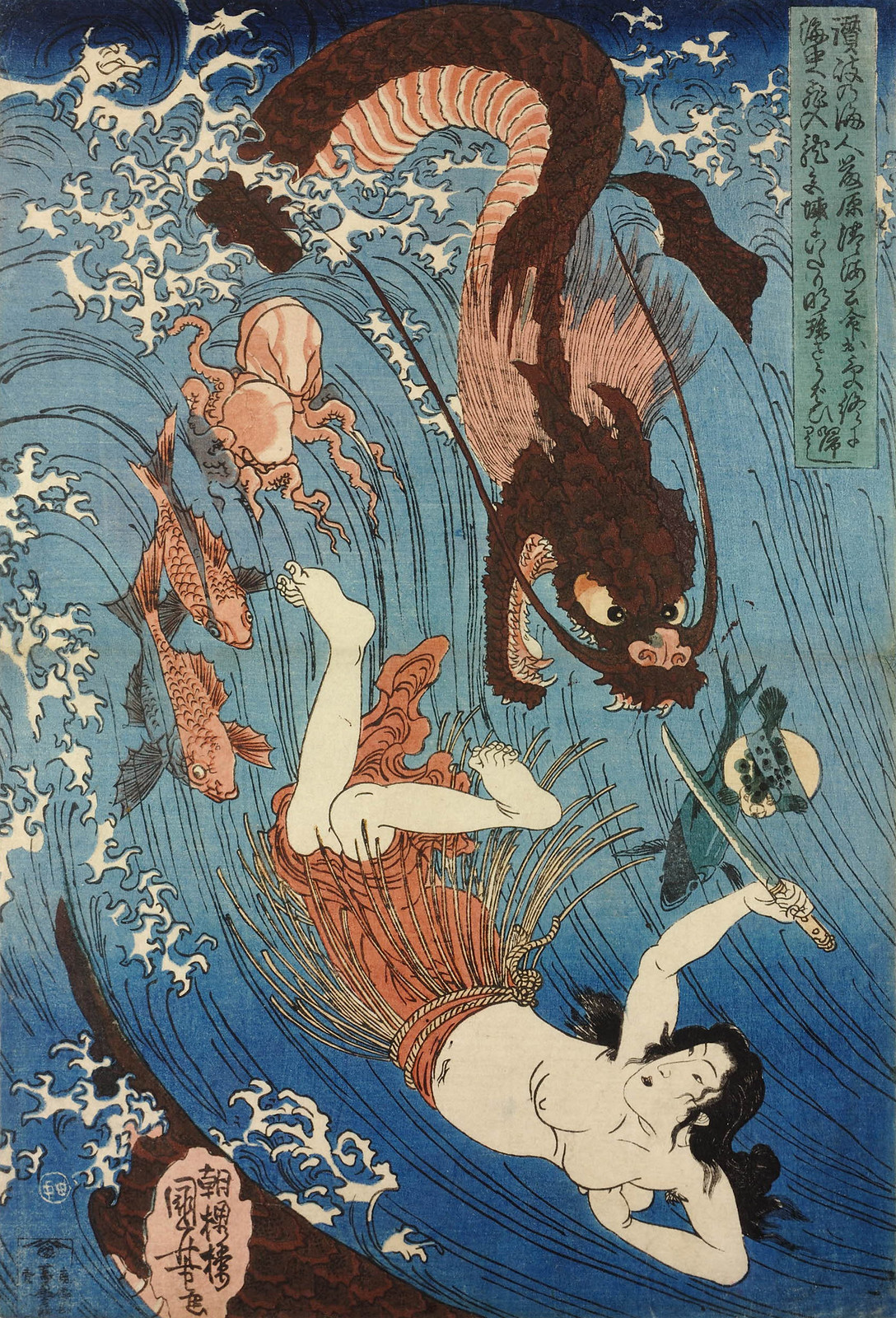 The diver Tamatori, who has penetrated the Dragon King's
palace, plunging through waves with outstretched knife and Treasure
Pearl, pursued by a dragon while escaping from the Dragon King, Edo
Period
The diver Tamatori, who has penetrated the Dragon King's
palace, plunging through waves with outstretched knife and Treasure
Pearl, pursued by a dragon while escaping from the Dragon King, Edo
Period  Usugumo (No. 19 Wisps of Cloud) 1845-46
Usugumo (No. 19 Wisps of Cloud) 1845-46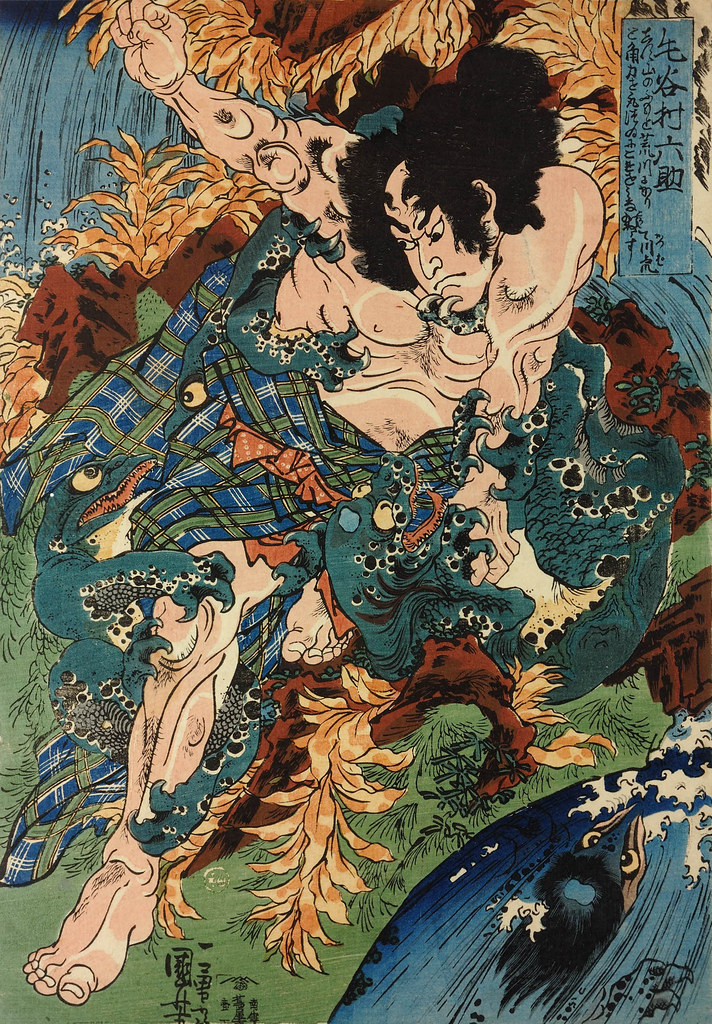 Keyamura Rokusuke struggling with three kappa on the bank of a river in which a fourth kappa also is swimming. Edo Period
Keyamura Rokusuke struggling with three kappa on the bank of a river in which a fourth kappa also is swimming. Edo Period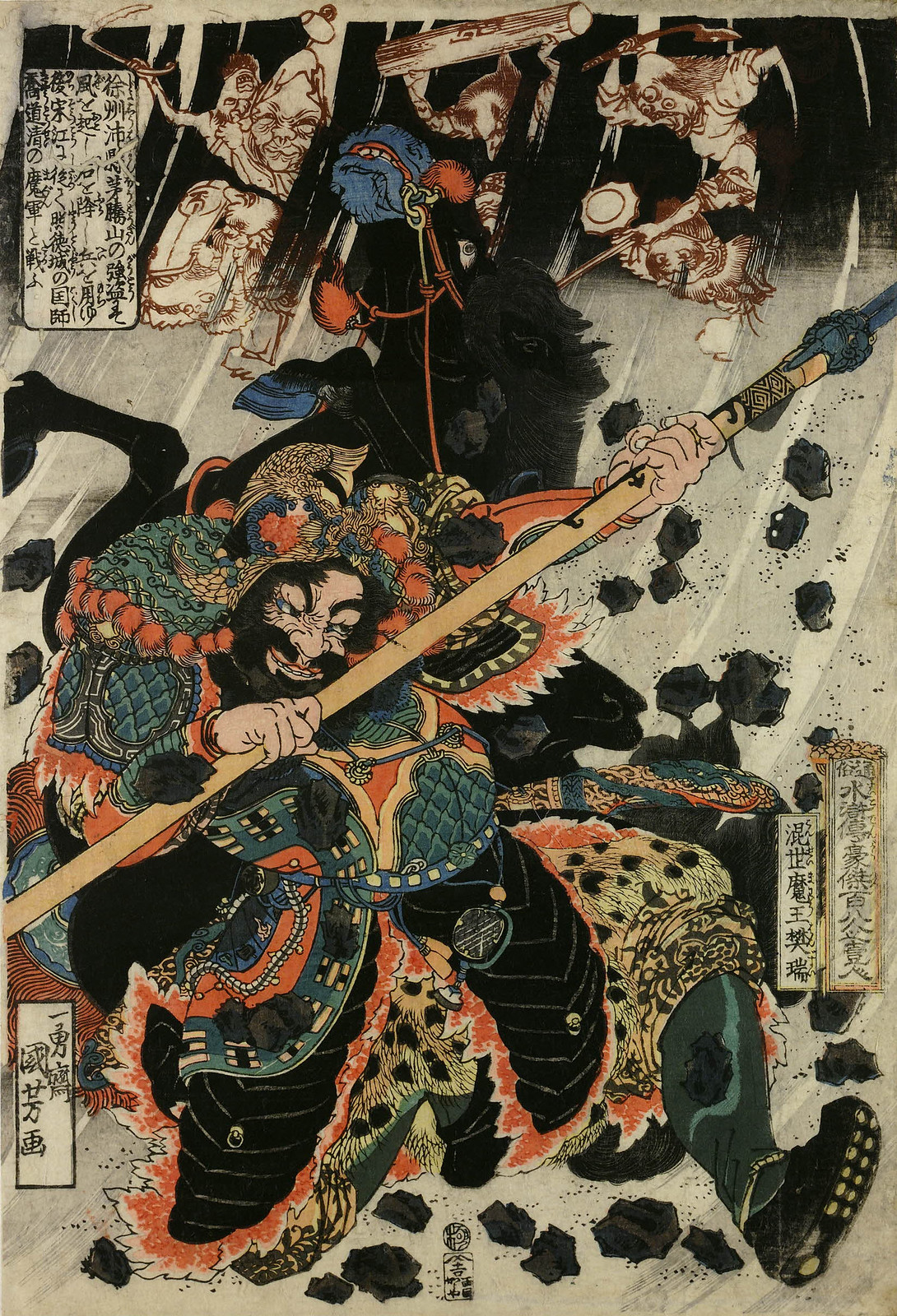 Tsuzoku Suikoden Goketsu Hyakuhachi-nin no Hitori Konsei Mao Bunzui invoking demons, stones and a storm by sorcery. 1827
Tsuzoku Suikoden Goketsu Hyakuhachi-nin no Hitori Konsei Mao Bunzui invoking demons, stones and a storm by sorcery. 1827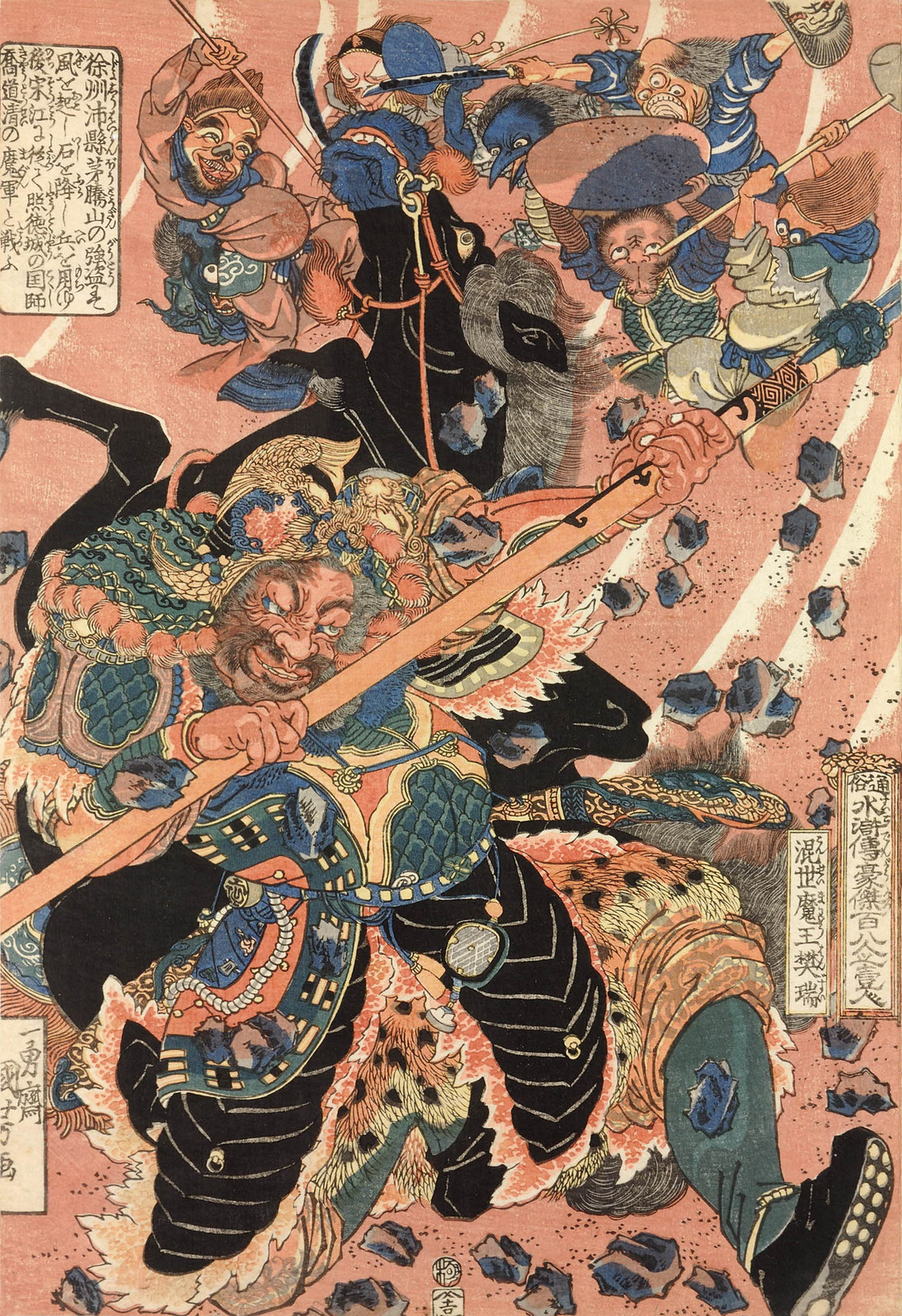 Tsuzoku Suikoden Goketsu Hyakuhachi-nin no Hitori Konsei Mao Bunzui
invoking demons, stones and a storm by sorcery. 1827 (version 2)
Tsuzoku Suikoden Goketsu Hyakuhachi-nin no Hitori Konsei Mao Bunzui
invoking demons, stones and a storm by sorcery. 1827 (version 2)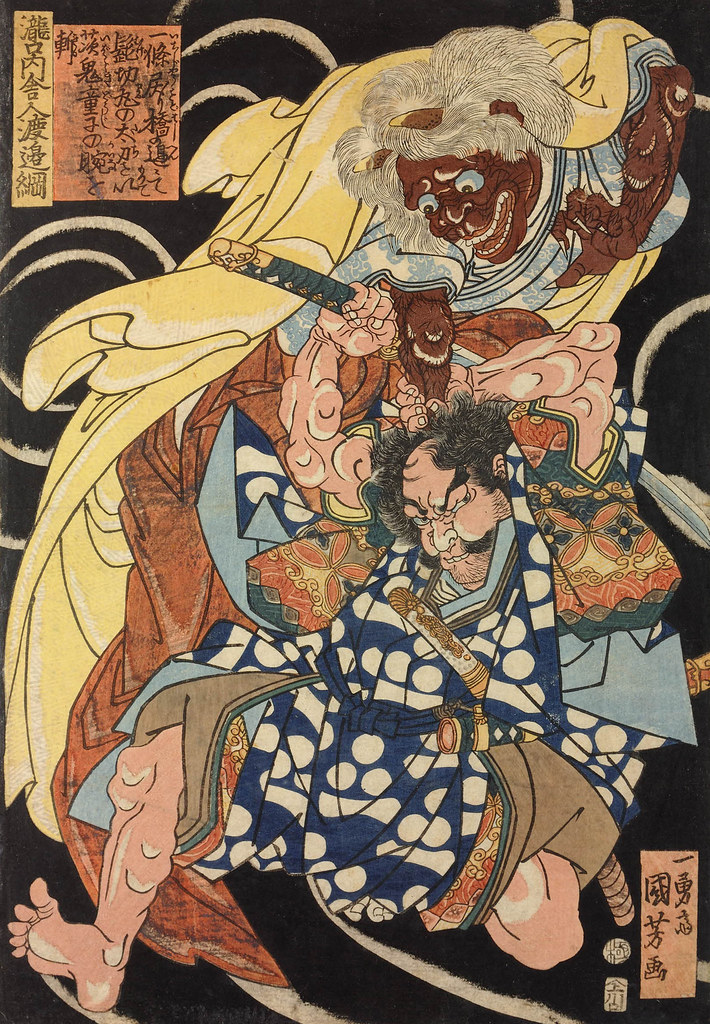 Watanabe Genji Tsuna, one of Raiko's Shitenno, grasping the arm
of the demon of the Rashomon Gate, Kyoto, while drawing his sword,
amidst lightning and clouds. Edo Period
Watanabe Genji Tsuna, one of Raiko's Shitenno, grasping the arm
of the demon of the Rashomon Gate, Kyoto, while drawing his sword,
amidst lightning and clouds. Edo Period 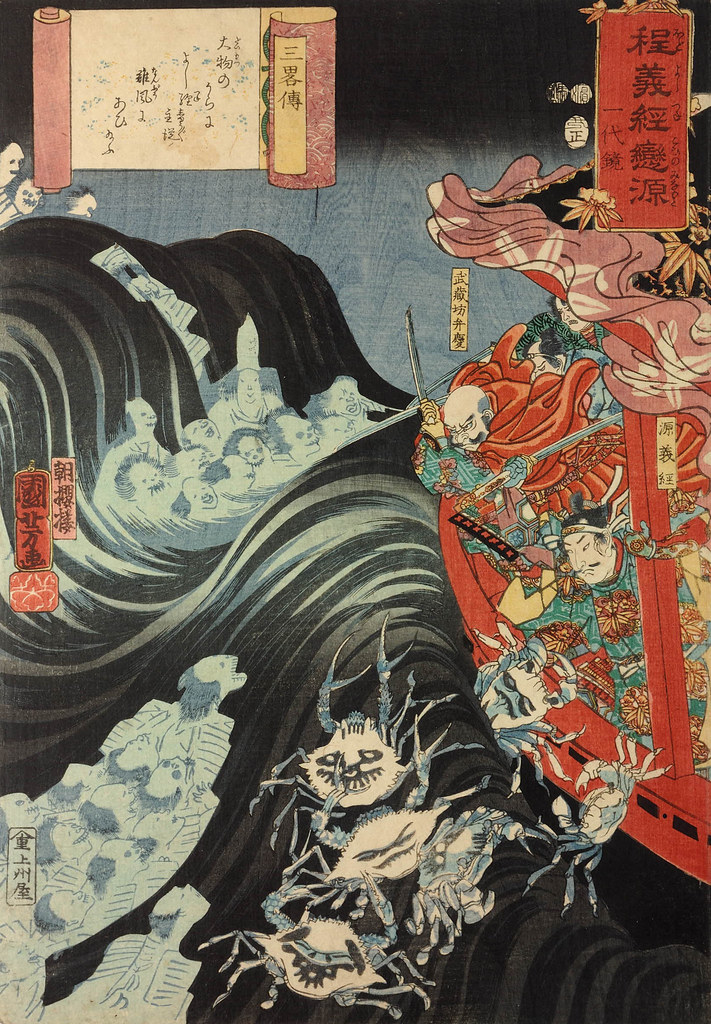 San ryaku den (The Secrets of Strategy) Hodo Yoshitsune koi no Minamoto ichidaigami (Biography of Yoshitsune) 1853
San ryaku den (The Secrets of Strategy) Hodo Yoshitsune koi no Minamoto ichidaigami (Biography of Yoshitsune) 1853 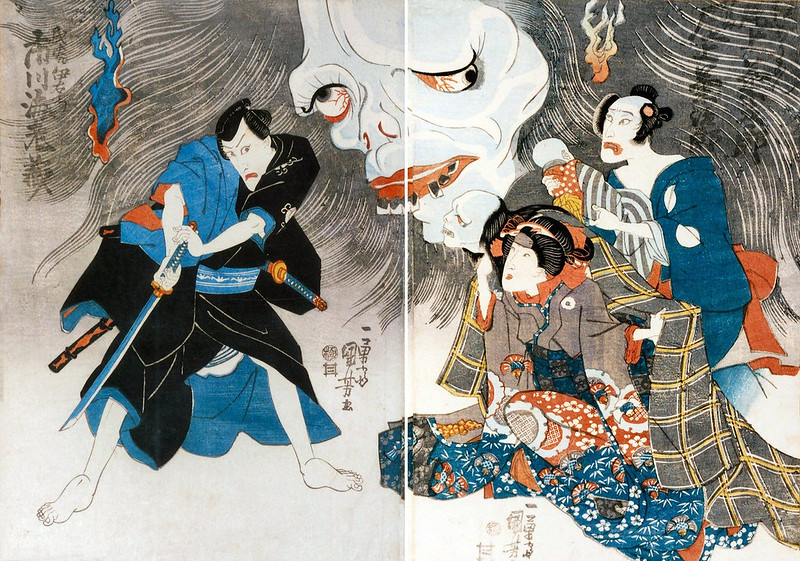 The Story of Oiwa and Tamiya Lemon, 1836
The Story of Oiwa and Tamiya Lemon, 1836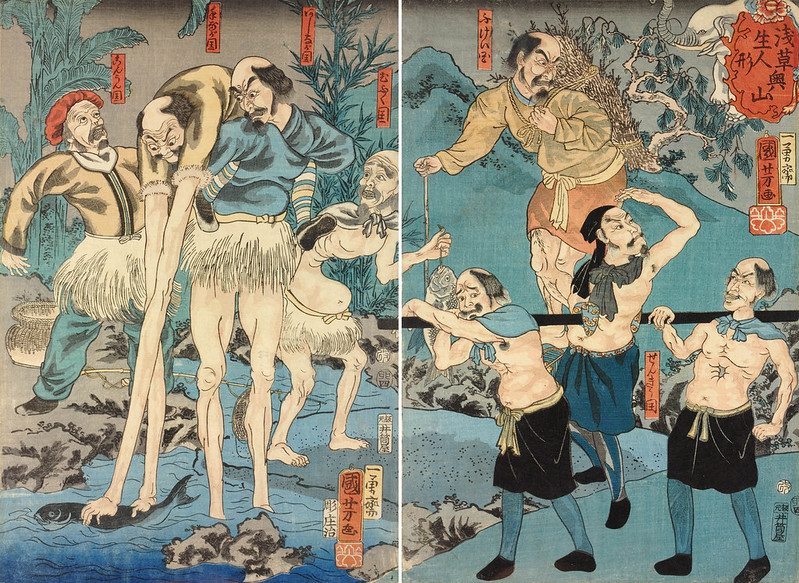 Living Dolls of Asakusa's Okuyama, 1855
Living Dolls of Asakusa's Okuyama, 1855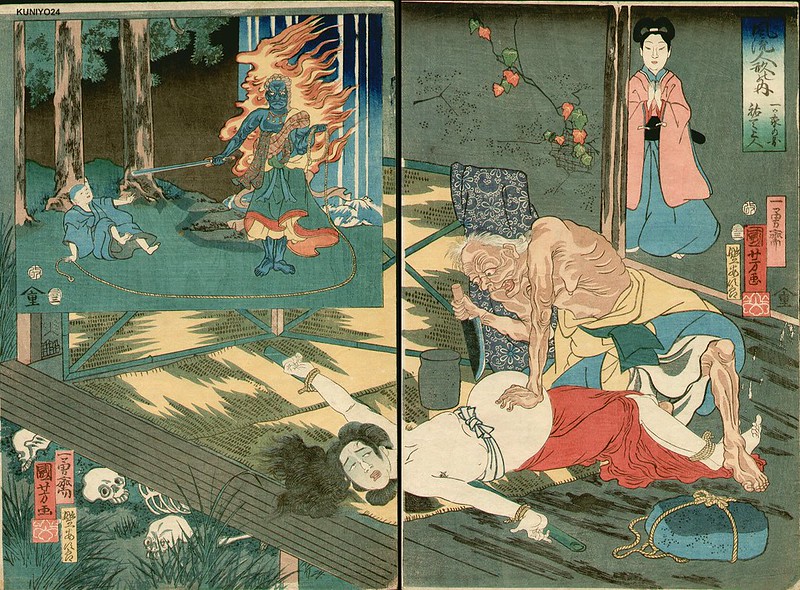 Title Unknown, 1856
Title Unknown, 1856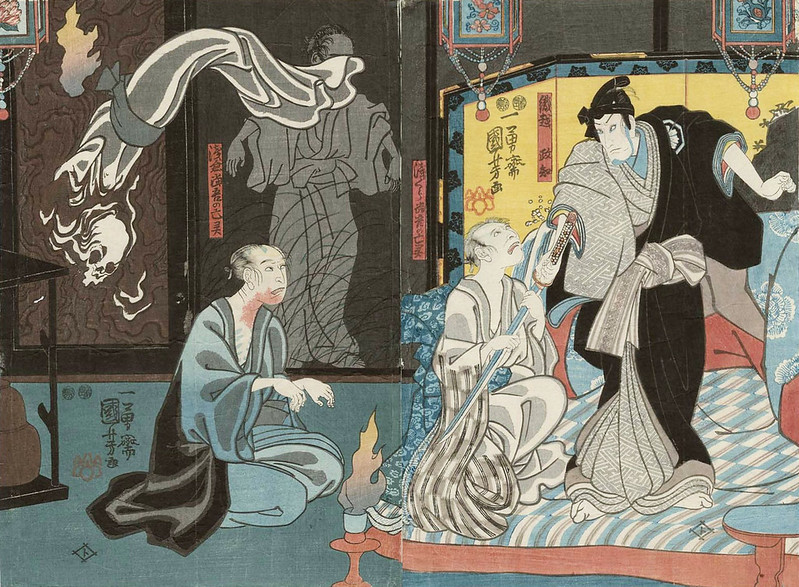 Leftside - Ichikawa Kodanji IV as the ghost of Shingo Asakura, Rightside - Ichikawa Kodanji IV as the ghost of Asakura Tôgo, 1847-52
Leftside - Ichikawa Kodanji IV as the ghost of Shingo Asakura, Rightside - Ichikawa Kodanji IV as the ghost of Asakura Tôgo, 1847-52 The sick Minamoto no Yorimitsu (Raiko) drawing his sword as the earth spider envelops him in its web. 1855
The sick Minamoto no Yorimitsu (Raiko) drawing his sword as the earth spider envelops him in its web. 1855 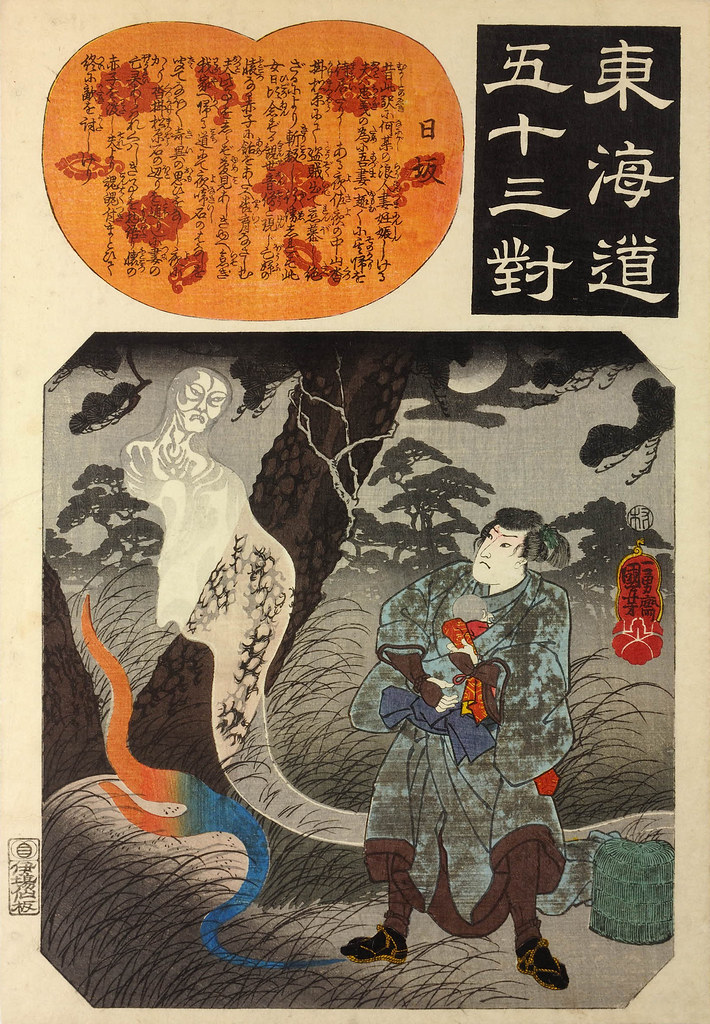 Moonlit scene of a travelling warrior receiving a child from a ghost, 1845
Moonlit scene of a travelling warrior receiving a child from a ghost, 1845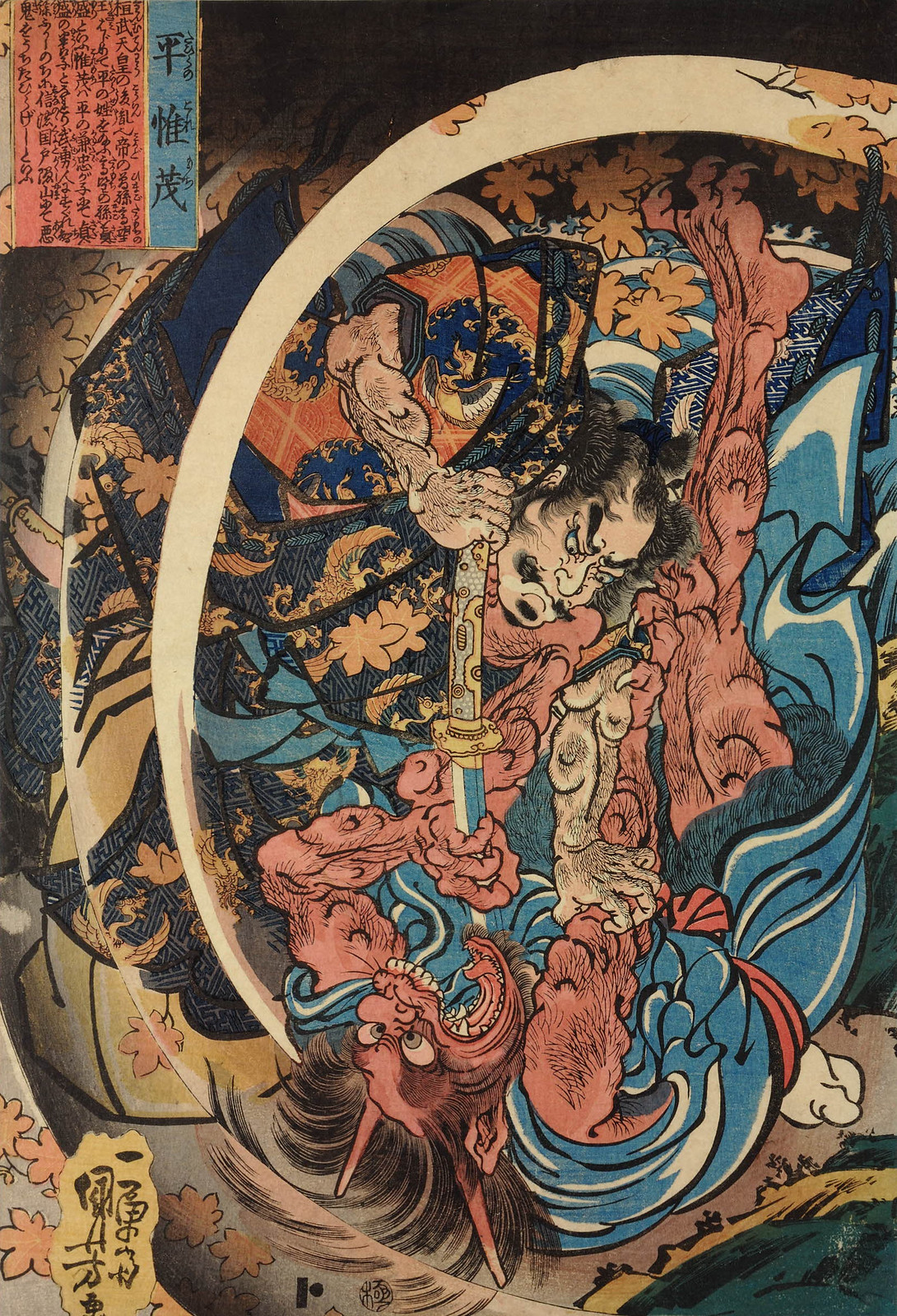 Taira no Koremochi killing the demon woman with a long sword. Edo Period
Taira no Koremochi killing the demon woman with a long sword. Edo Period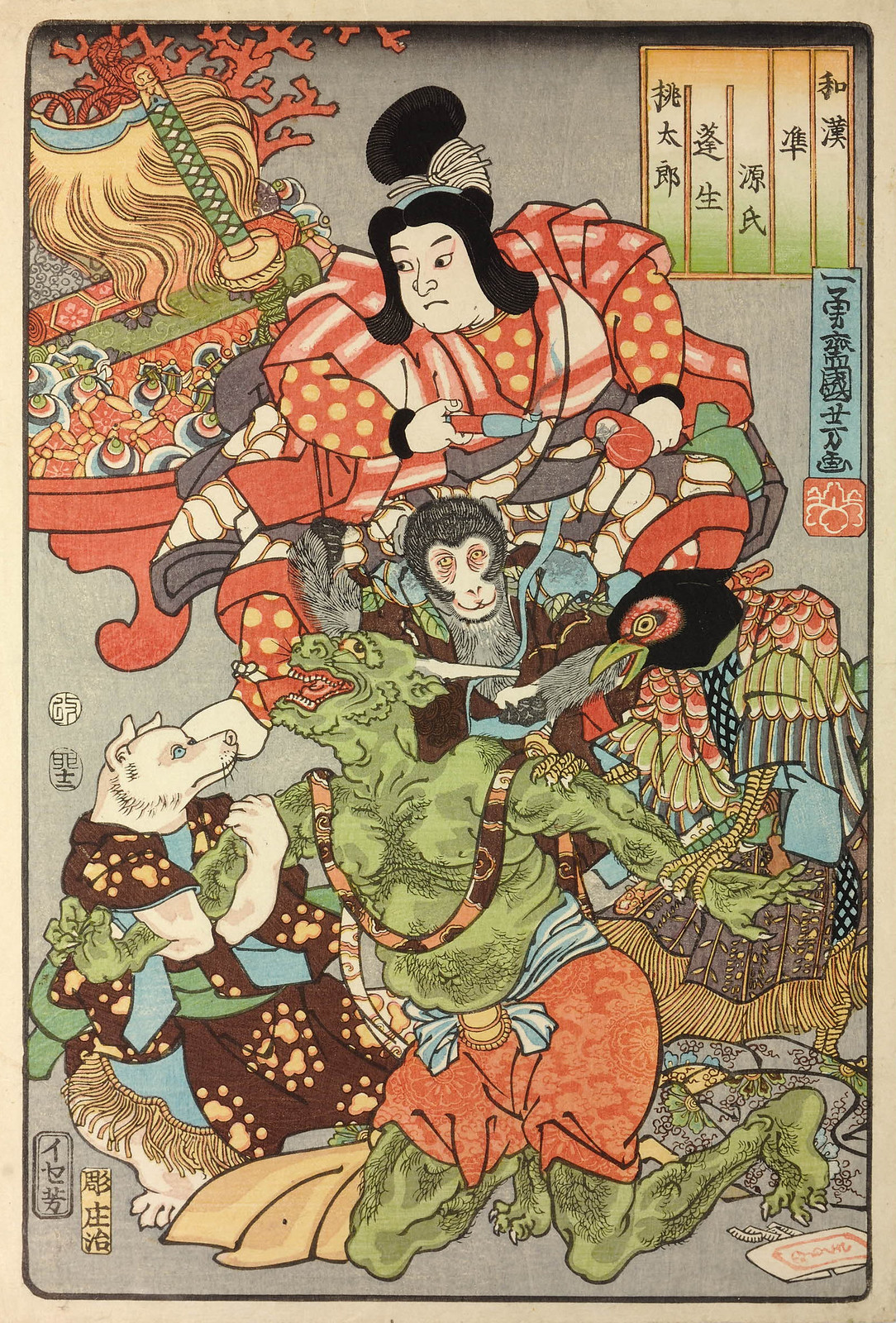 Momotaro and his companions the monkey, the badger, and the pheasant,
with a captive demon. The Five Precious Things; on a
stand behind them, 1855
Momotaro and his companions the monkey, the badger, and the pheasant,
with a captive demon. The Five Precious Things; on a
stand behind them, 1855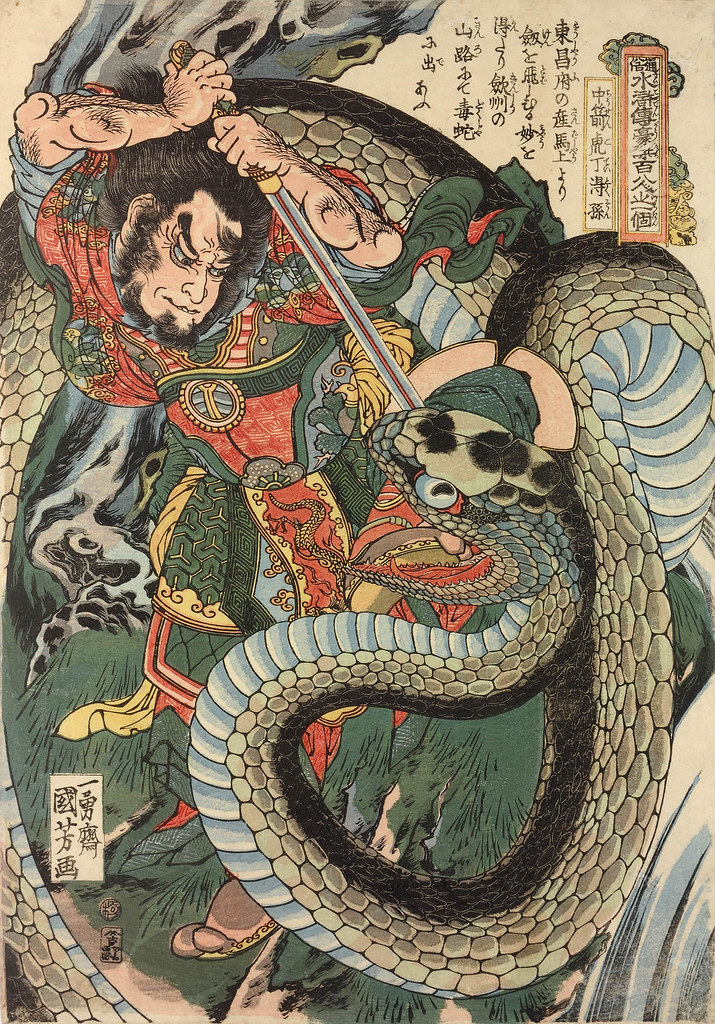 Tsuzoku Suikoden Goketsu Hyakuhachi-nin no Hitori, Chusenko Teitoku-Son killing huge blue snake with his sword. 1827
Tsuzoku Suikoden Goketsu Hyakuhachi-nin no Hitori, Chusenko Teitoku-Son killing huge blue snake with his sword. 1827 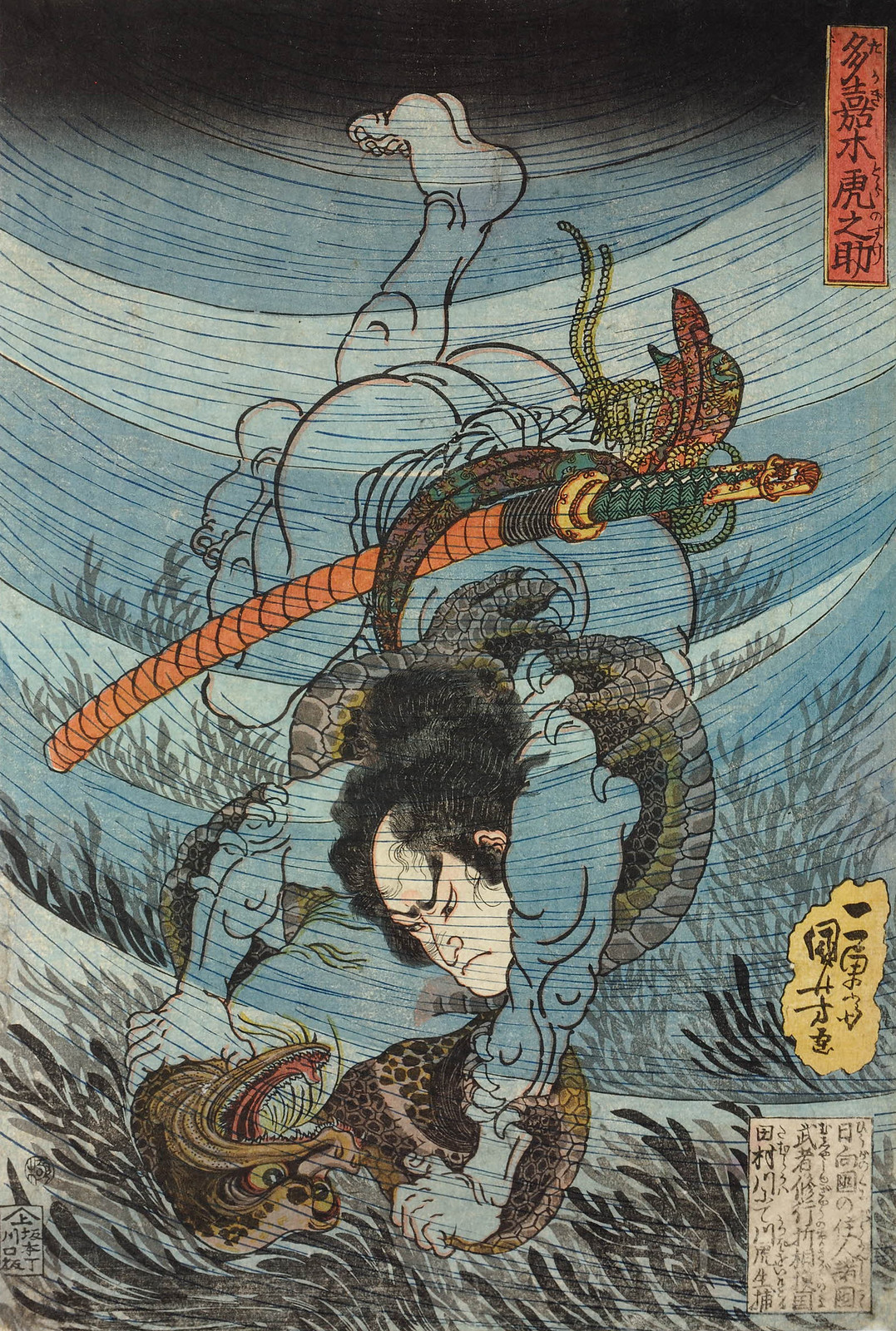 Takagi Toranosuke capturing a kappa under the water in the Tamura river in the province of Sagami. Edo Period
Takagi Toranosuke capturing a kappa under the water in the Tamura river in the province of Sagami. Edo Period Takeuchi-no-sukune looking over the side of his ship, being offered two magic jewels, senju and manju, by the Dragon King. 1855
Takeuchi-no-sukune looking over the side of his ship, being offered two magic jewels, senju and manju, by the Dragon King. 1855 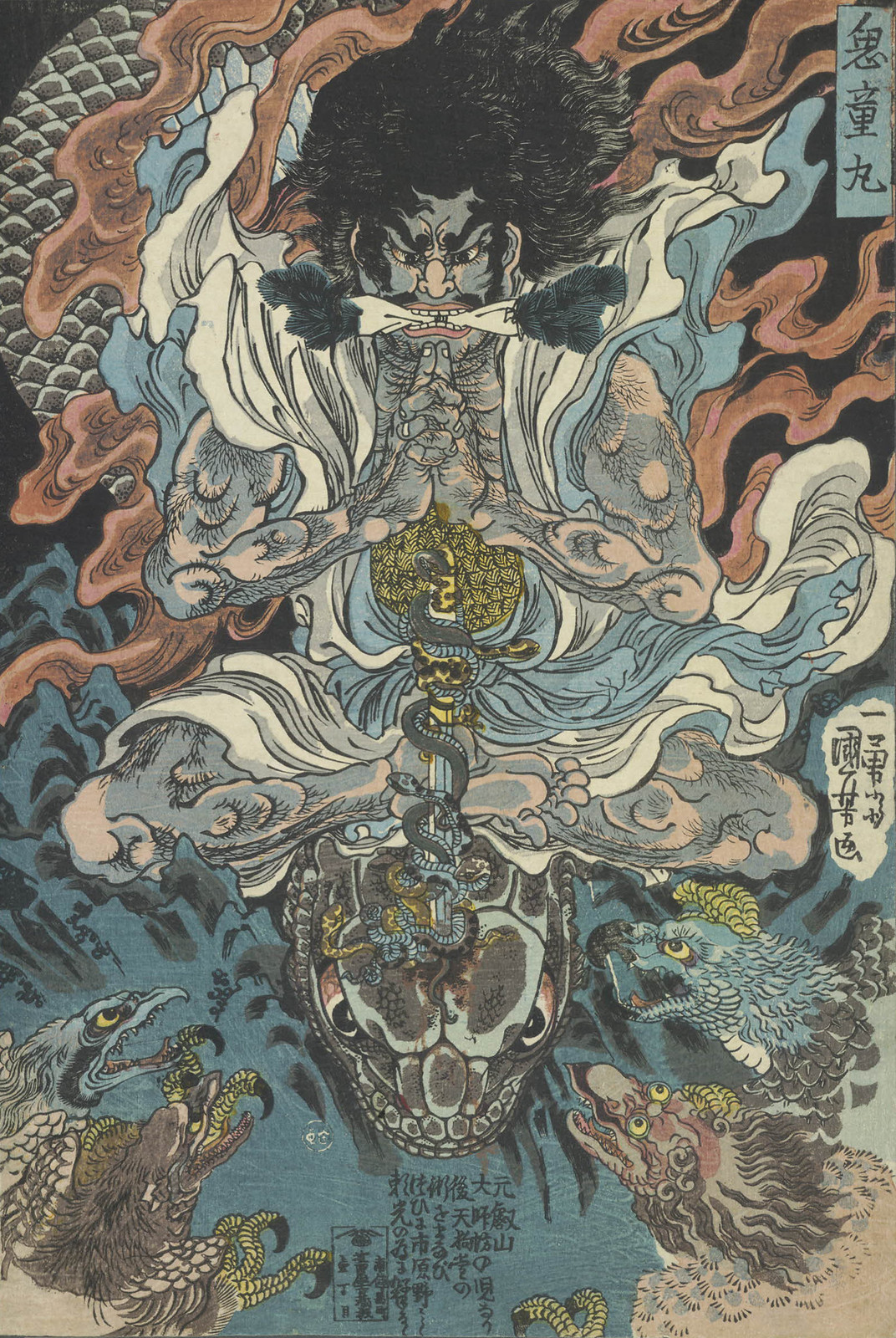 Kidomaru seated cross-legged on the head of a giant python, learning magic from the tengu, 1843
Kidomaru seated cross-legged on the head of a giant python, learning magic from the tengu, 1843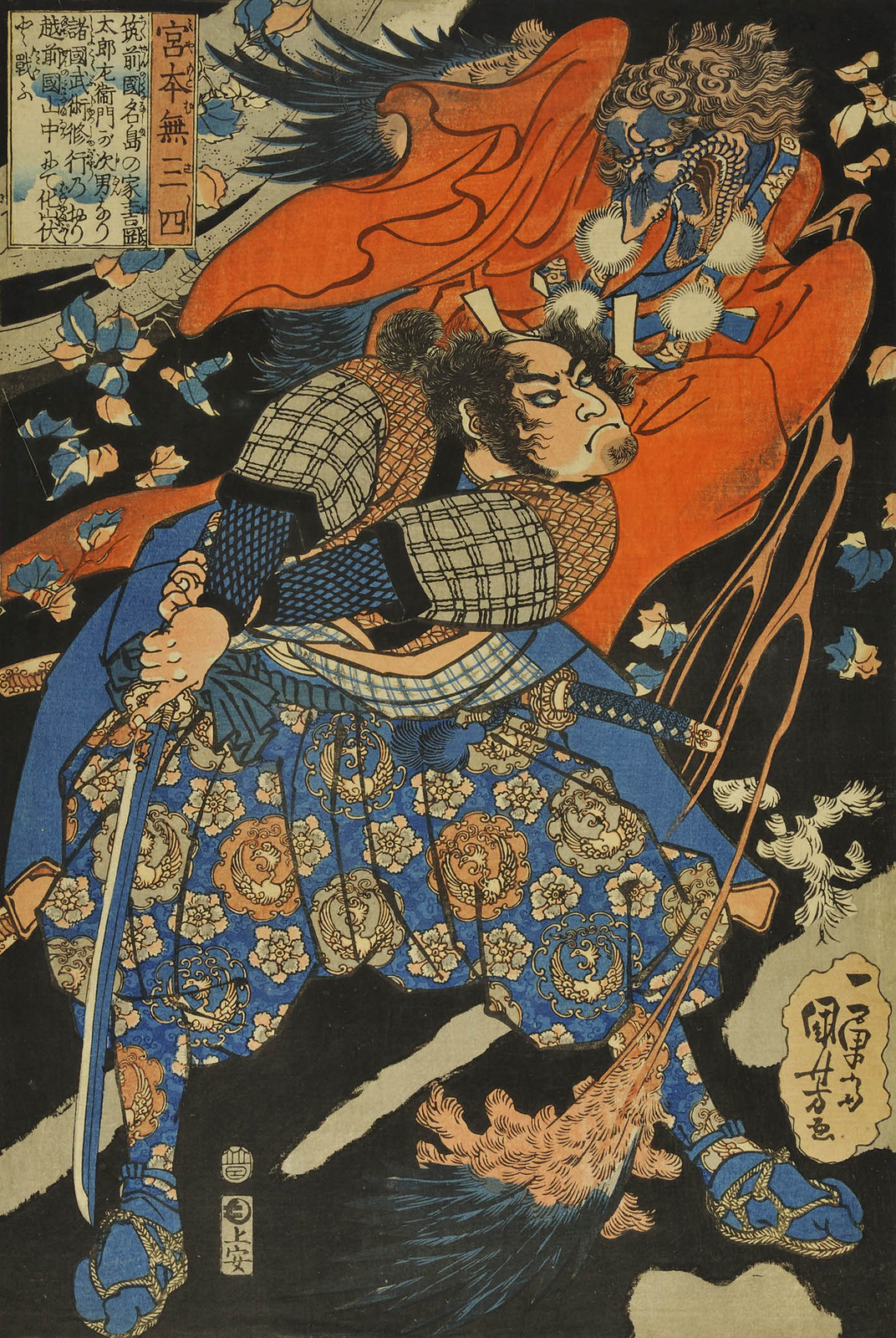 The famous swordsman Miyamoto Musashi battling with a mountain hermit who has turned into a monster. Edo Period
The famous swordsman Miyamoto Musashi battling with a mountain hermit who has turned into a monster. Edo Period 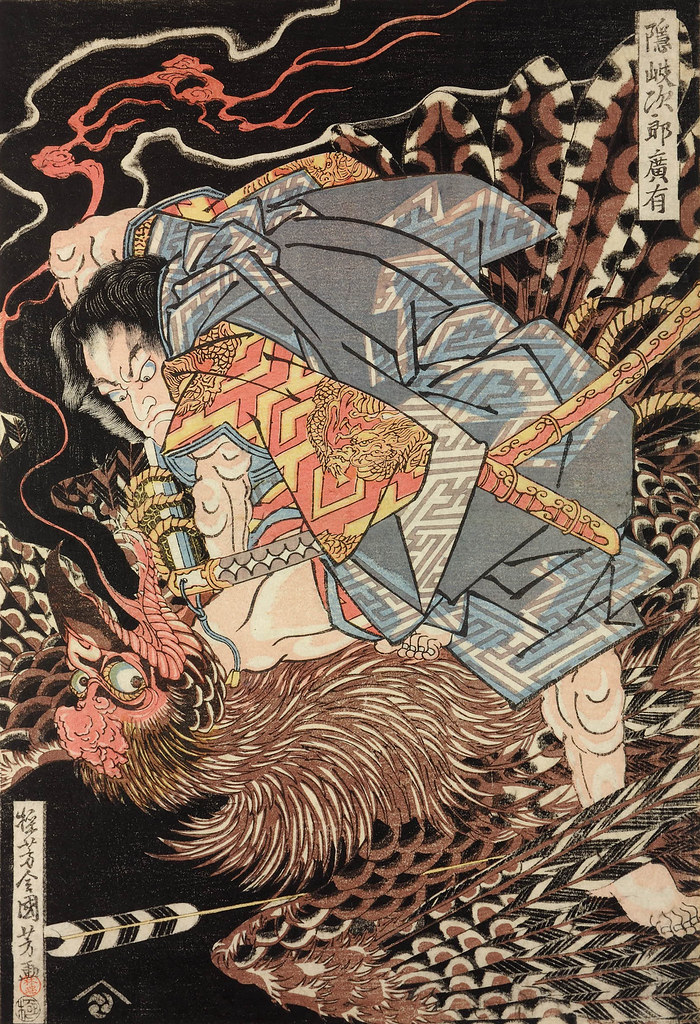 Oki Jiro Hiroari battling the nue, revealed to be a giant tengu (bird-like goblin) 1815-19
Oki Jiro Hiroari battling the nue, revealed to be a giant tengu (bird-like goblin) 1815-19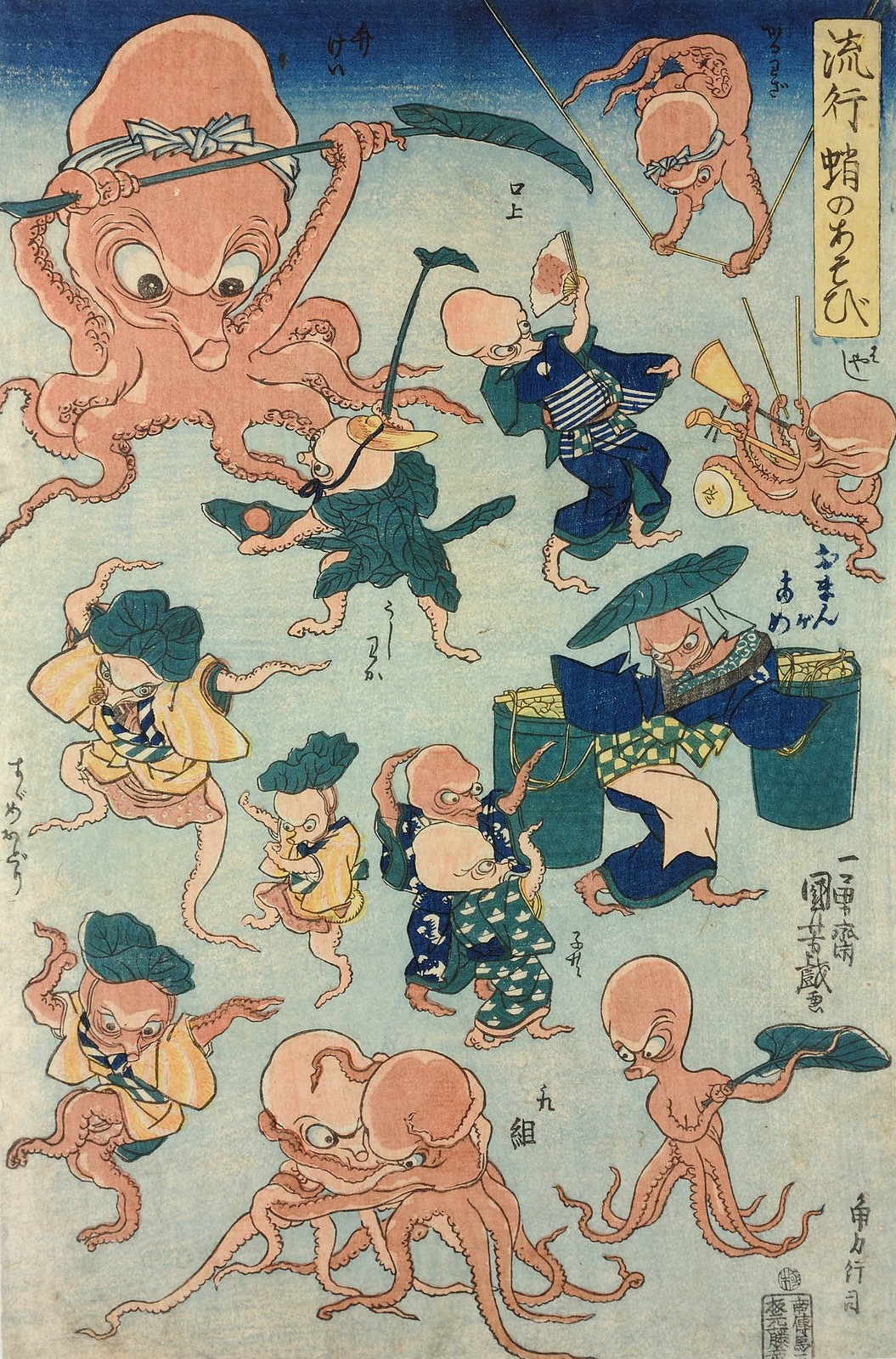 Ryuko tako no asobi (Fashionable Octopus Games) 1840-42
Ryuko tako no asobi (Fashionable Octopus Games) 1840-42 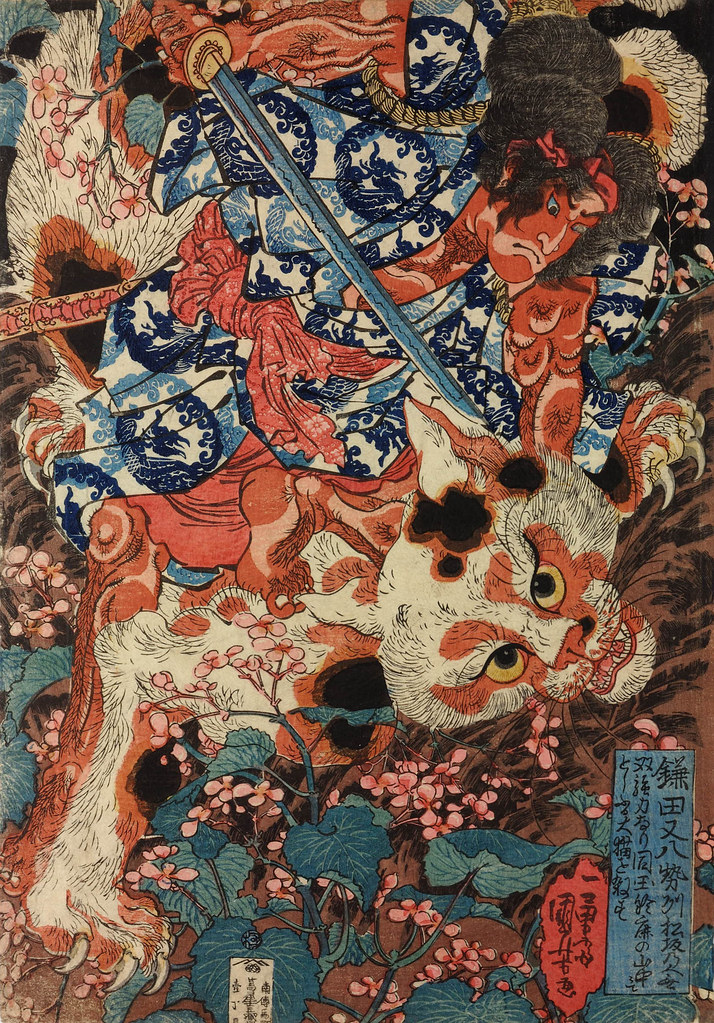 Kamada Matahachi killing a monstrous cat in the mountains of Ise Province. Edo Period
Kamada Matahachi killing a monstrous cat in the mountains of Ise Province. Edo Period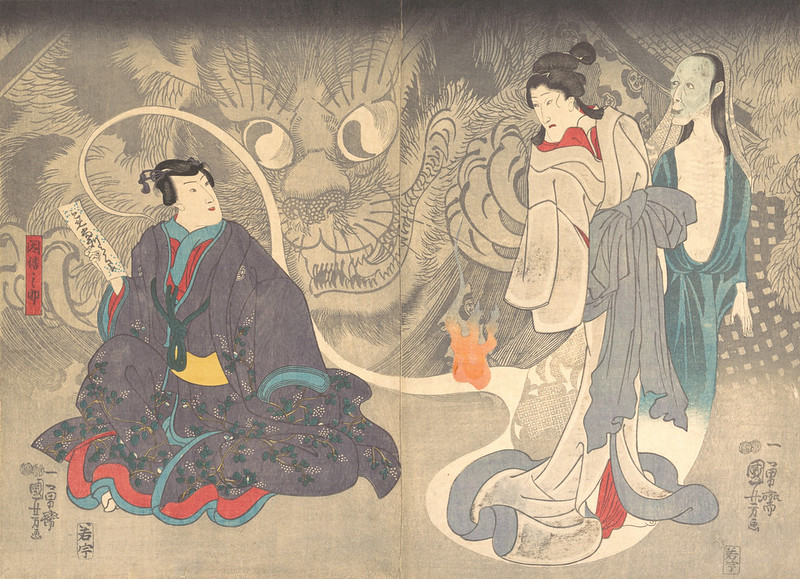 Scene from a Ghost Story - The Okazaki Cat Demon, 19th C
Scene from a Ghost Story - The Okazaki Cat Demon, 19th C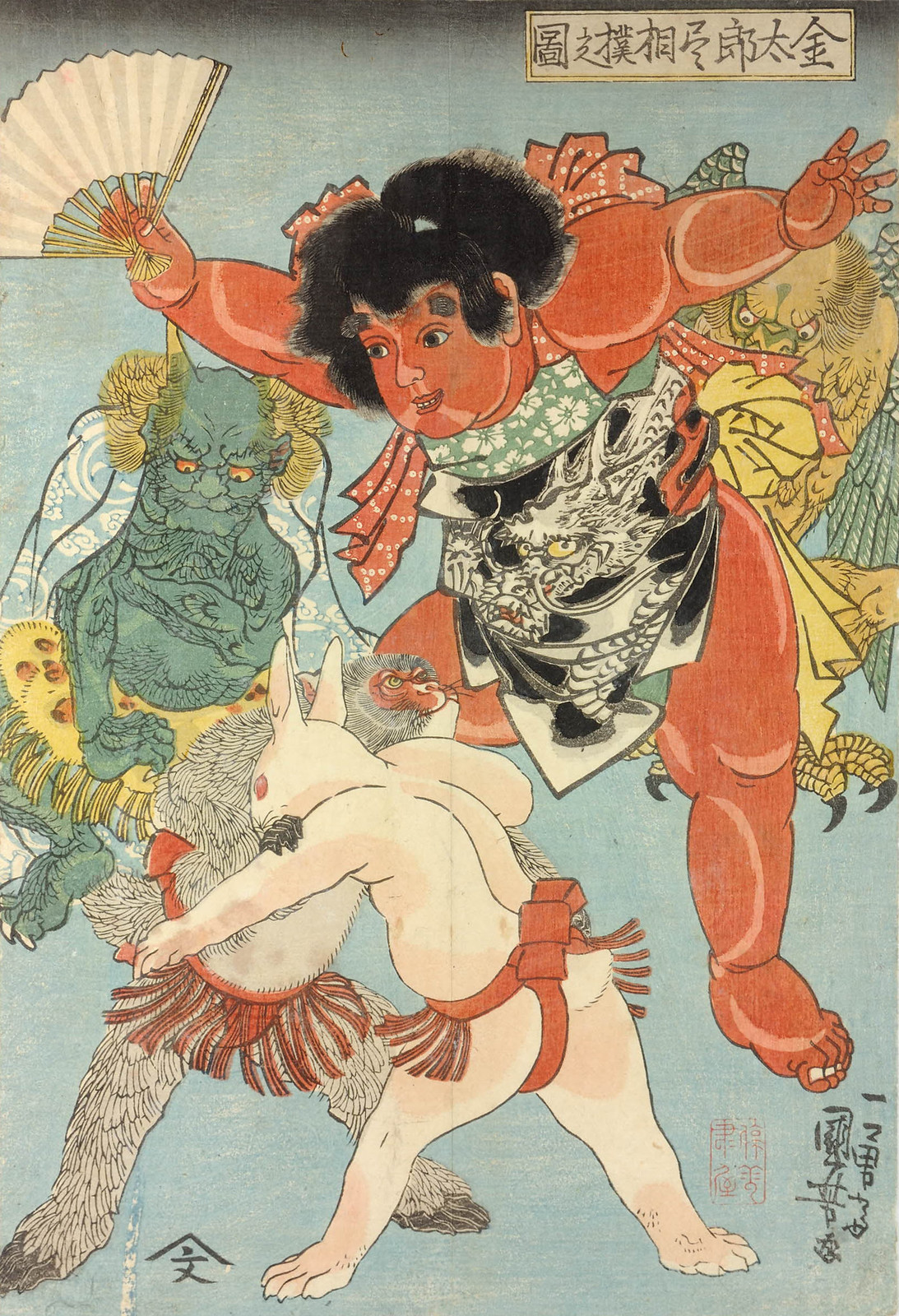 Kintaro zukushi - Sumo no zu (The Complete Kintaro - The Sumo Bout) 1840
Kintaro zukushi - Sumo no zu (The Complete Kintaro - The Sumo Bout) 1840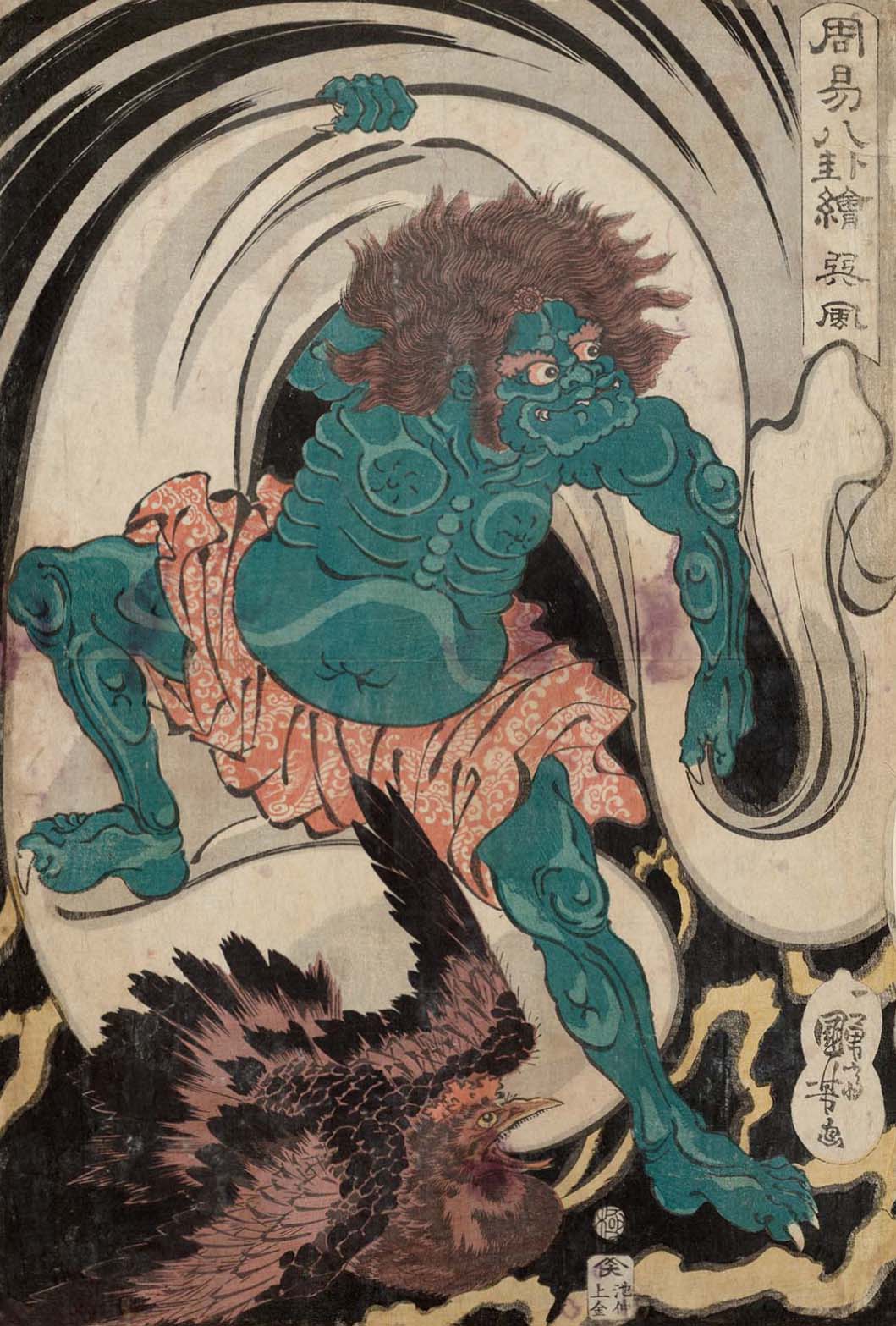 The Trigram Xun or Wind (Son, kaze), from the series Pictures of the
Eight Trigrams in Chinese Divination (Shûeki hakke e) 1830's
The Trigram Xun or Wind (Son, kaze), from the series Pictures of the
Eight Trigrams in Chinese Divination (Shûeki hakke e) 1830's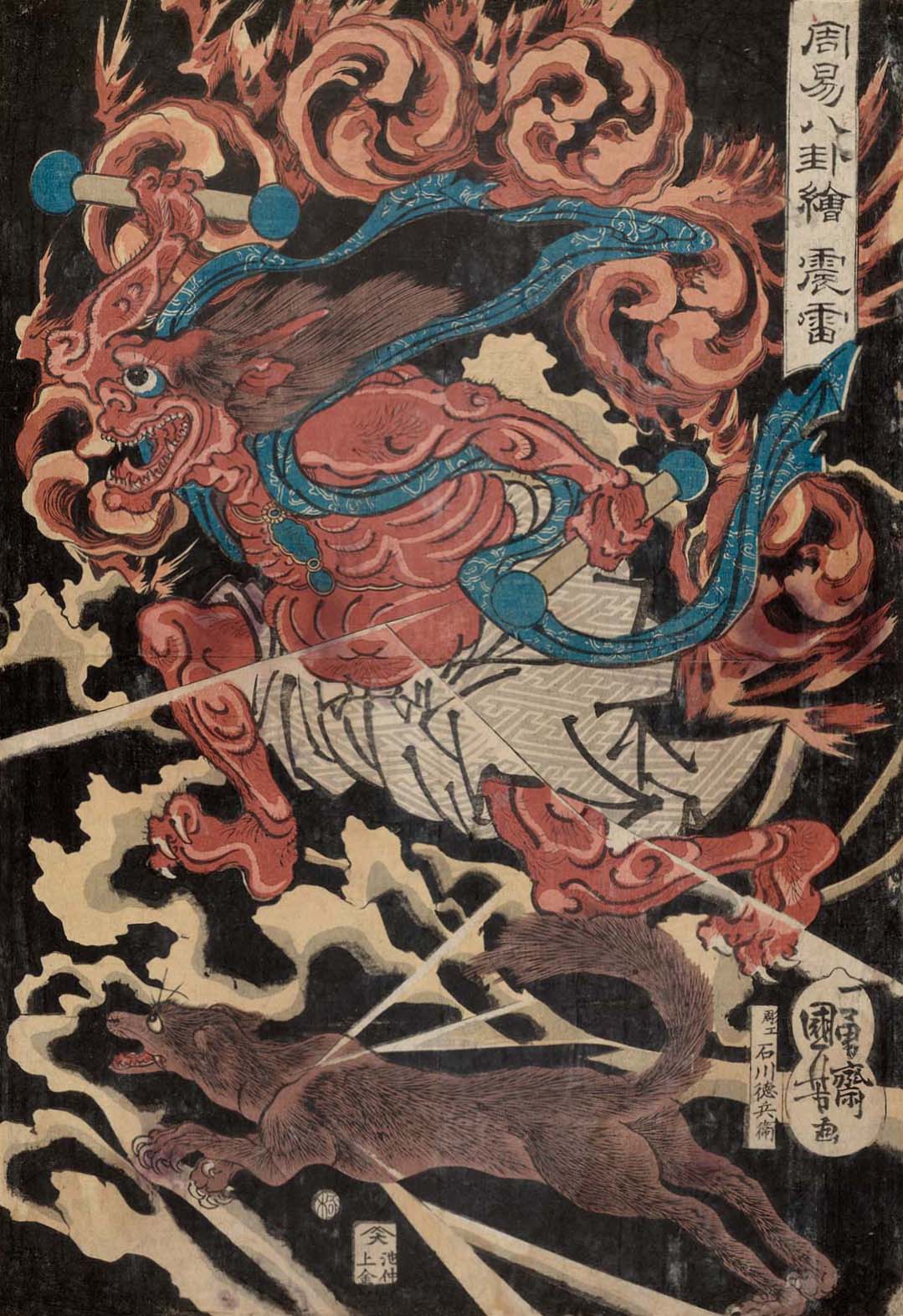 The Trigram Zhen or Thunder (Shin, kaminari), from the series Pictures
of the Eight Trigrams in Chinese Divination (Shûeki hakke e) 1830's
The Trigram Zhen or Thunder (Shin, kaminari), from the series Pictures
of the Eight Trigrams in Chinese Divination (Shûeki hakke e) 1830's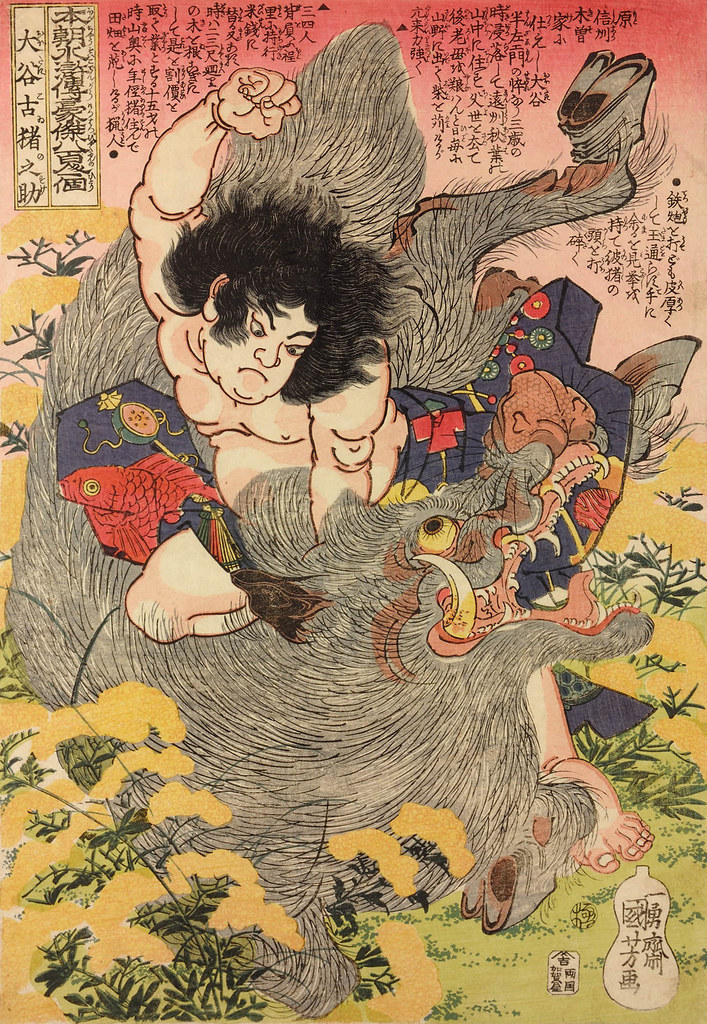 Ôtani Furuinosuke, from the series Eight Hundred Heroes of the Japanese
Shuihuzhuan (Honchô Suikoden gôyû happyakunin no hitori) 1845
Ôtani Furuinosuke, from the series Eight Hundred Heroes of the Japanese
Shuihuzhuan (Honchô Suikoden gôyû happyakunin no hitori) 1845 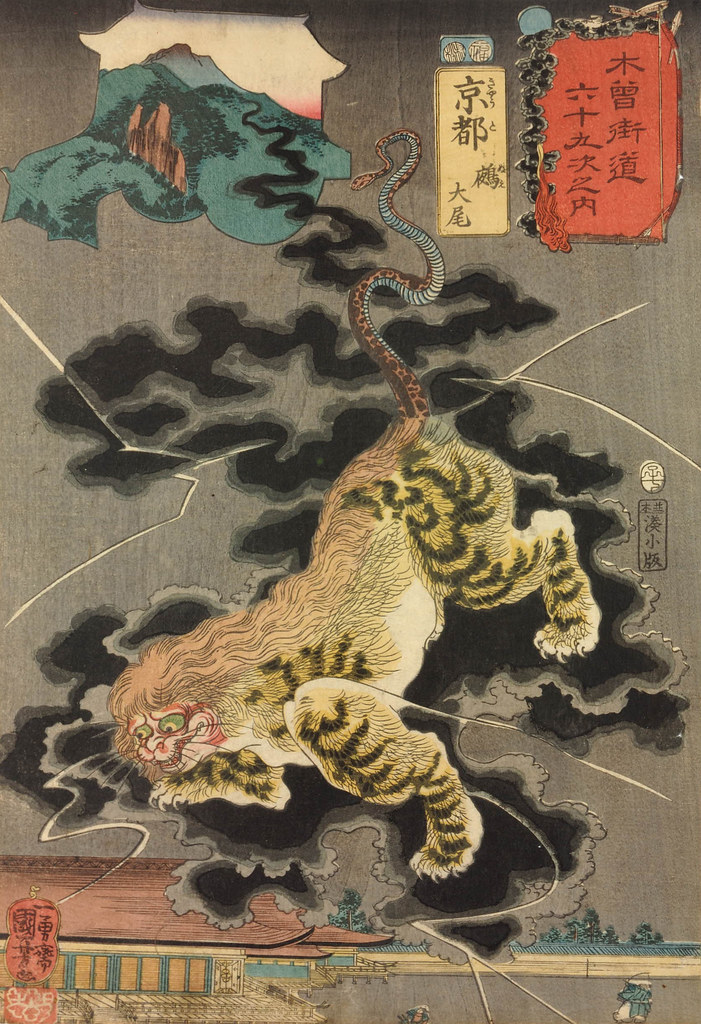 Kisokaido rokujoku tsugi no uchi (Sixty-Nine Post Stations of the Kisokaido) 1852
Kisokaido rokujoku tsugi no uchi (Sixty-Nine Post Stations of the Kisokaido) 1852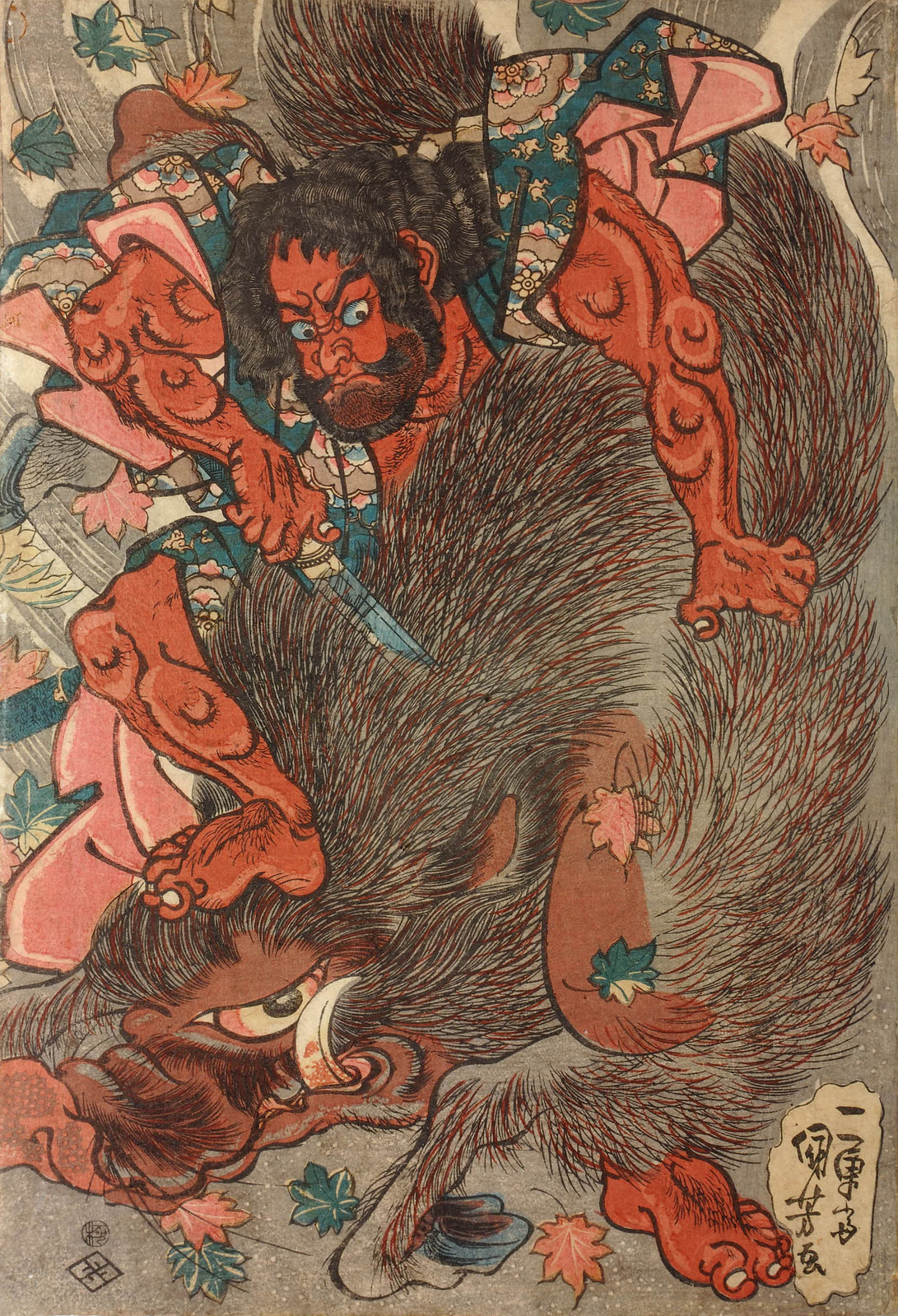 Saganoike Heikuro Masatora, a retainer of Kusunoki Masashige, killing the monstrous wild giant boar with a sword, 19th C
Saganoike Heikuro Masatora, a retainer of Kusunoki Masashige, killing the monstrous wild giant boar with a sword, 19th C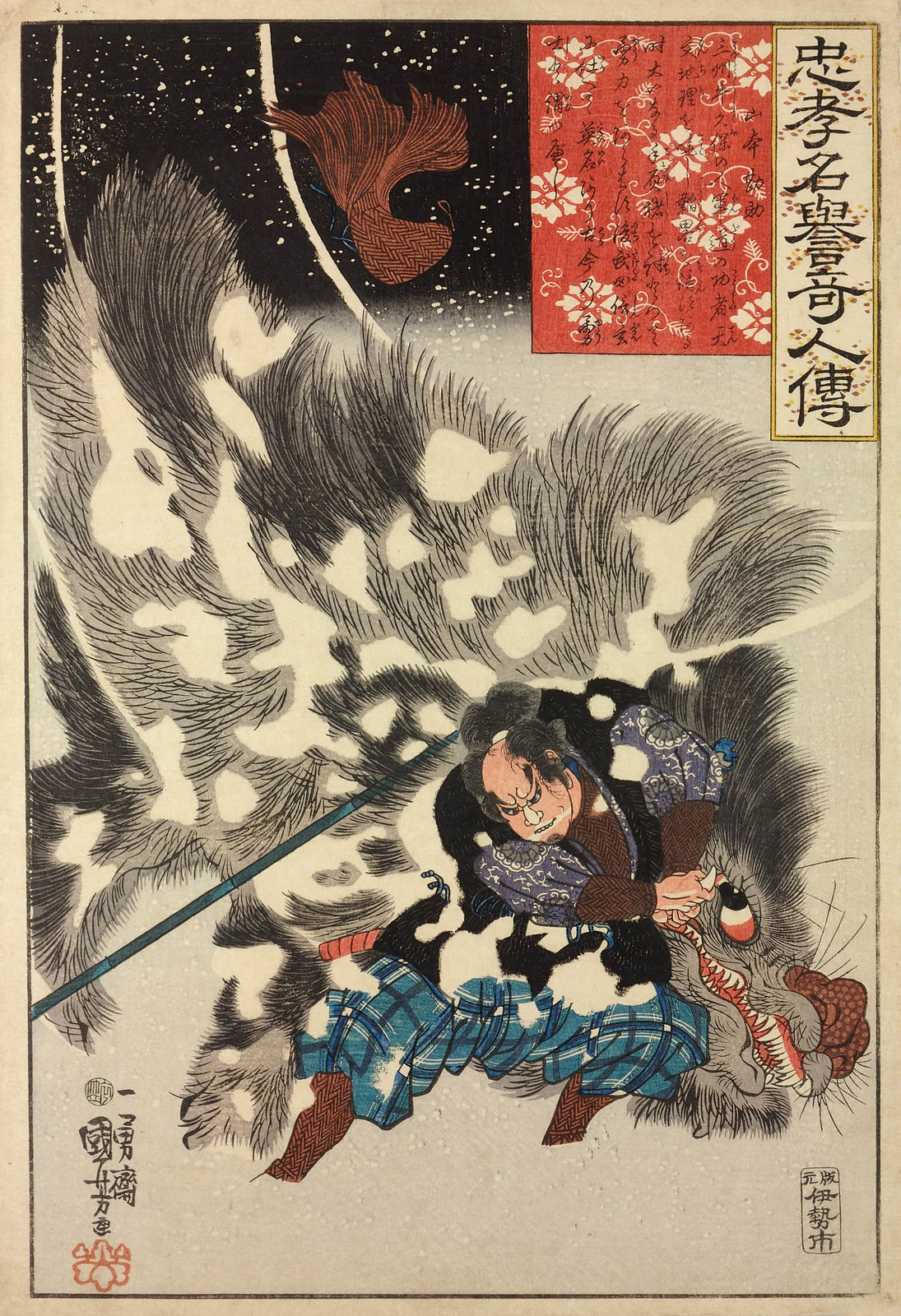 Yamamoto Kansuke, from the series Lives of Remarkable People Renowned for Loyalty and Virtue (Chûkô meiyo kijin den) 1845
Yamamoto Kansuke, from the series Lives of Remarkable People Renowned for Loyalty and Virtue (Chûkô meiyo kijin den) 1845 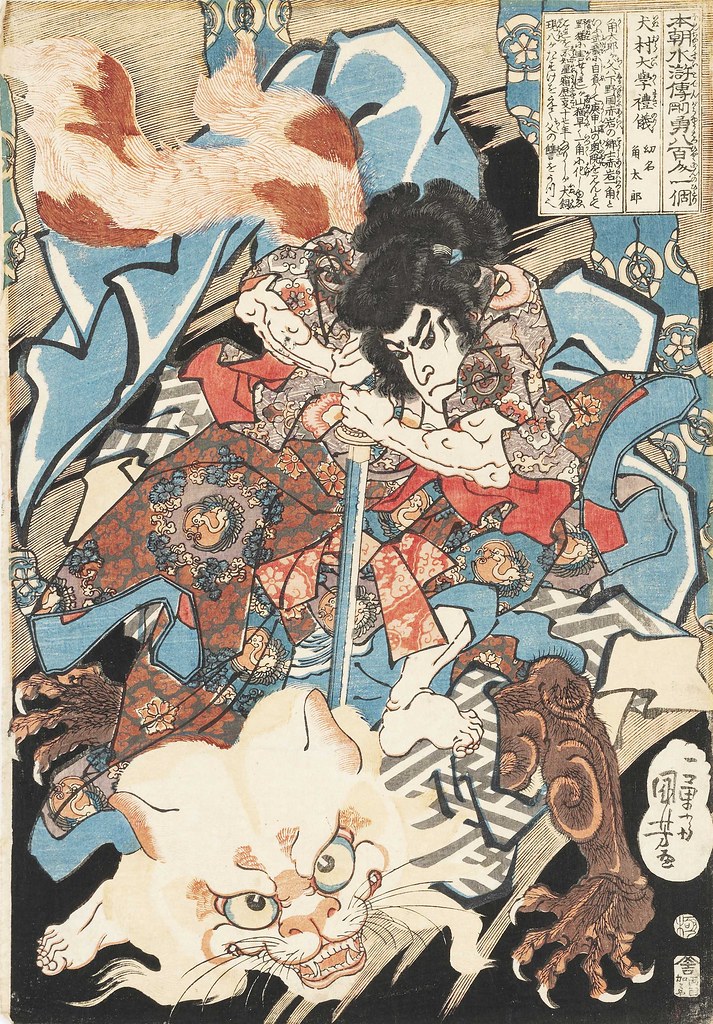 Inamura Daikaku Masanori killing the monstrous witch cat of Koshin-yama, 19th C
Inamura Daikaku Masanori killing the monstrous witch cat of Koshin-yama, 19th C Izumo no Imaro, 1834-35
Izumo no Imaro, 1834-35 Koshibe no Sugaru Captures a Thunder Monster in Toyora Village (Koshibe no Sugaru Toyora no sato ni rai o torau) 1834-35
Koshibe no Sugaru Captures a Thunder Monster in Toyora Village (Koshibe no Sugaru Toyora no sato ni rai o torau) 1834-35 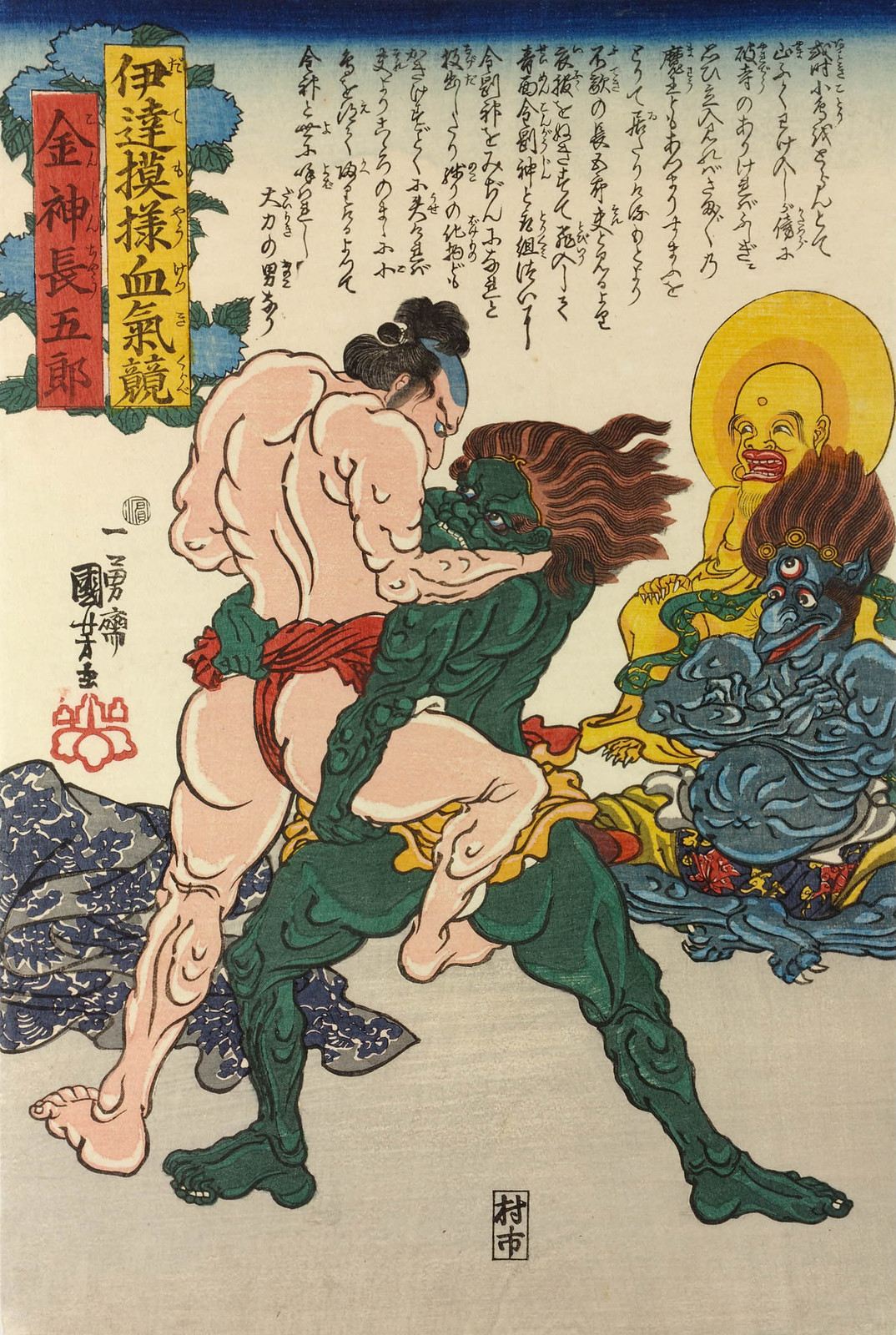 Konjin Chôgorô, from the series Contest of Hot-blooded Heroes in Bold Patterns (Date moyô kekki kurabe) 1845-46
Konjin Chôgorô, from the series Contest of Hot-blooded Heroes in Bold Patterns (Date moyô kekki kurabe) 1845-46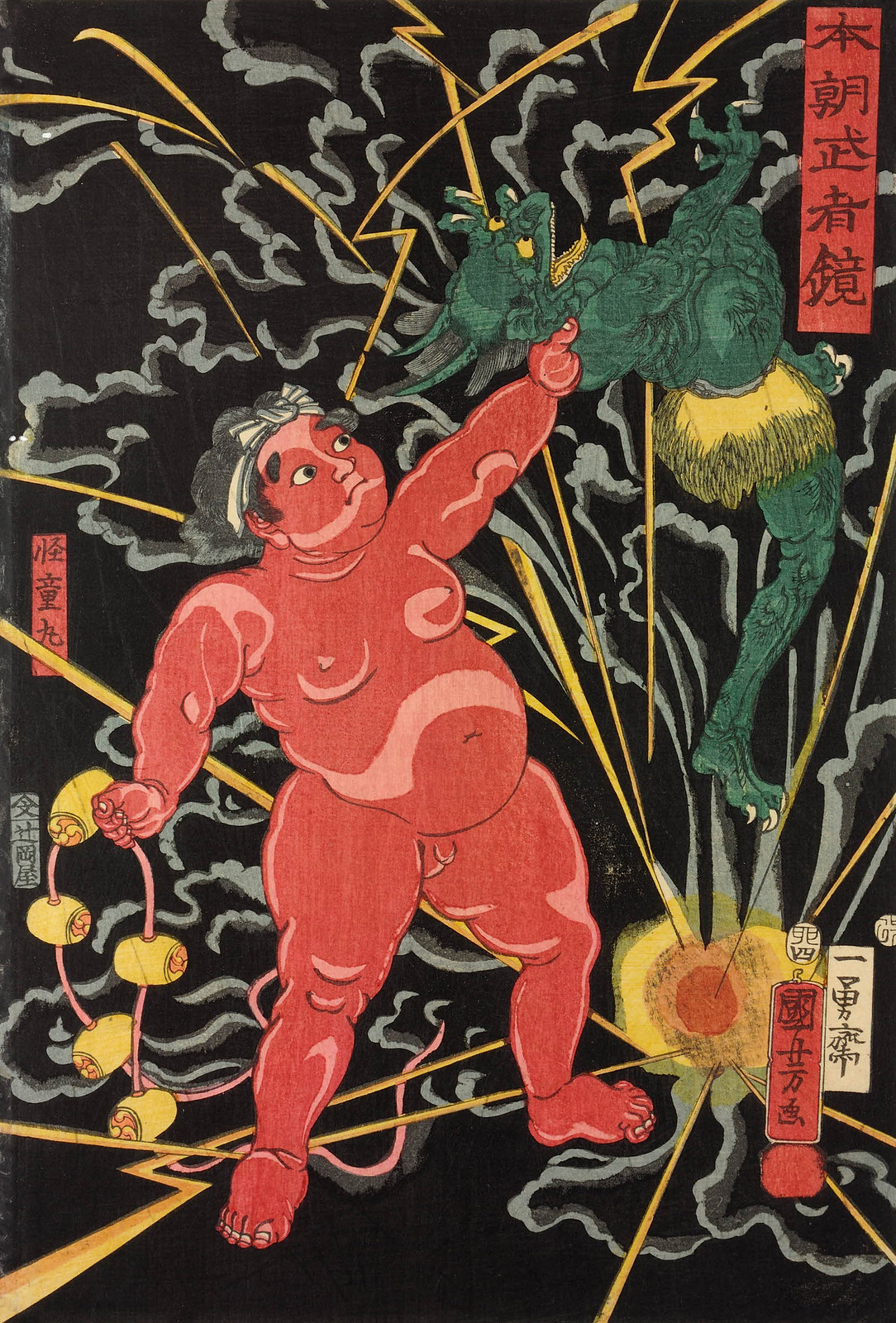 Honcho musha kagami (Mirror of Warriors of Our Country) Kintaro seizing Raijin the thundergod, 1855
Honcho musha kagami (Mirror of Warriors of Our Country) Kintaro seizing Raijin the thundergod, 1855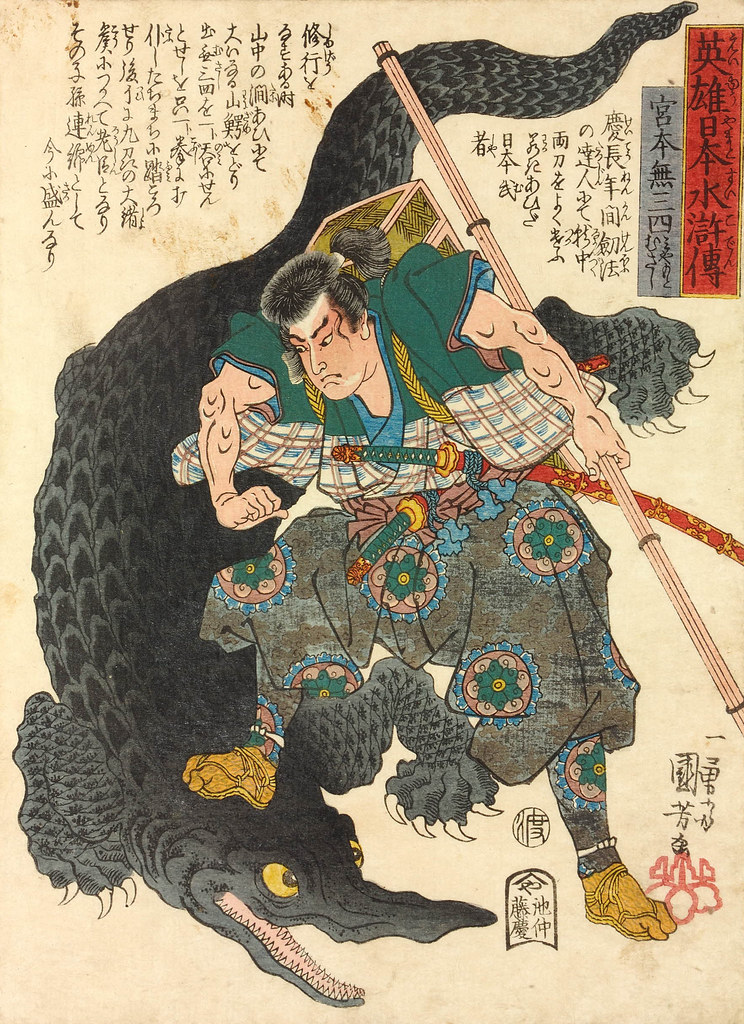 MIyamoto Musashi, from the series A Suikoden of Japanese Heroes (Eiyû Nihon Suikoden) 1843
MIyamoto Musashi, from the series A Suikoden of Japanese Heroes (Eiyû Nihon Suikoden) 1843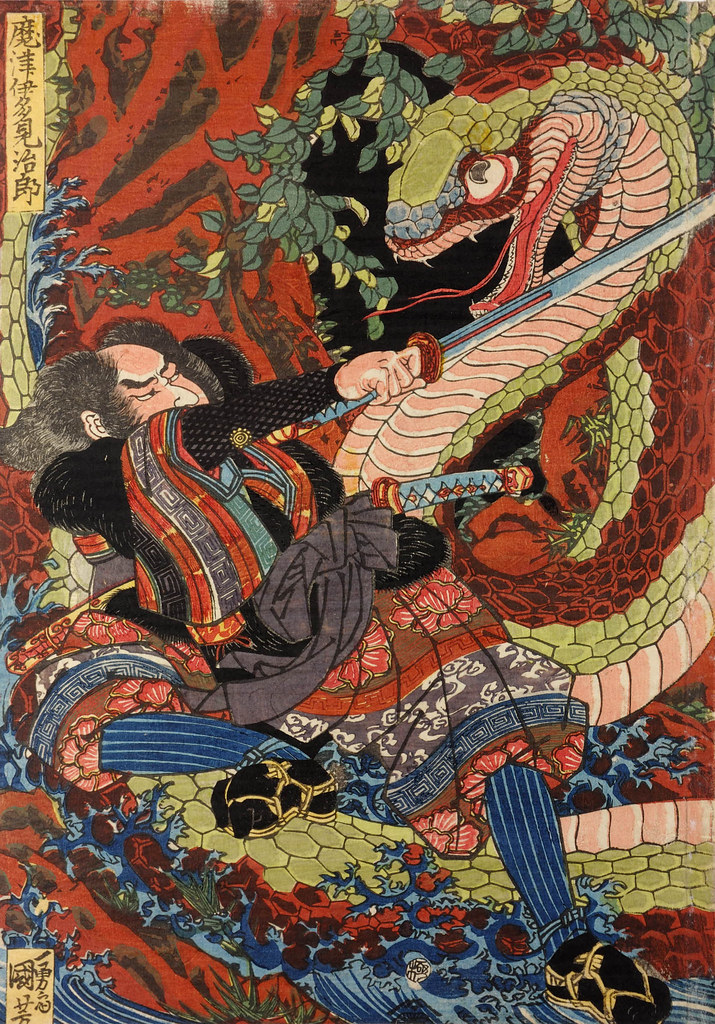 Matsui Tamijiro, sword in hand, fighting a giant snake, Edo Period
Matsui Tamijiro, sword in hand, fighting a giant snake, Edo Period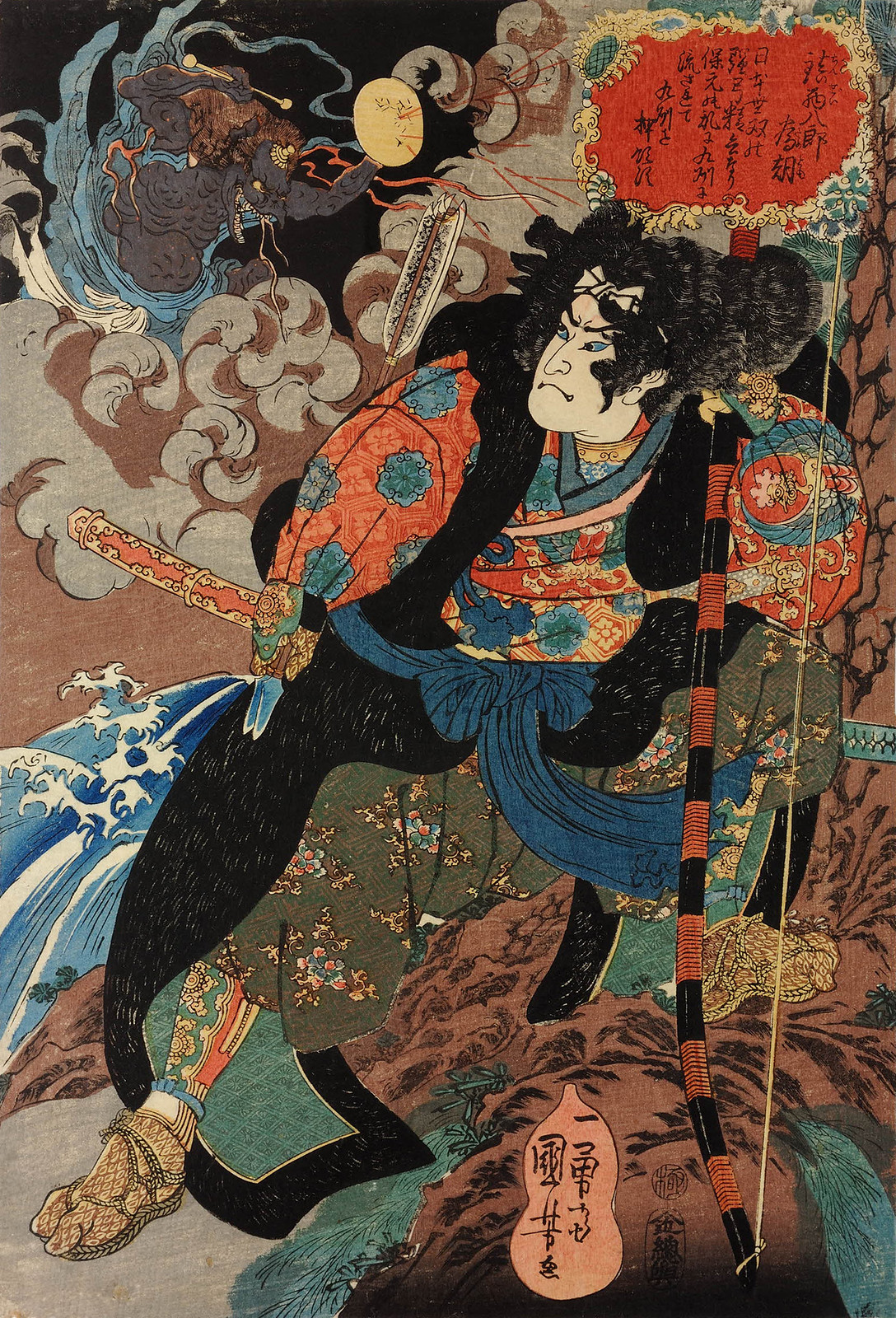 Chinzei Hachiro Tametomo and Raiden, god of thunder, at a waterfall in Kyushu, Edo Period
Chinzei Hachiro Tametomo and Raiden, god of thunder, at a waterfall in Kyushu, Edo Period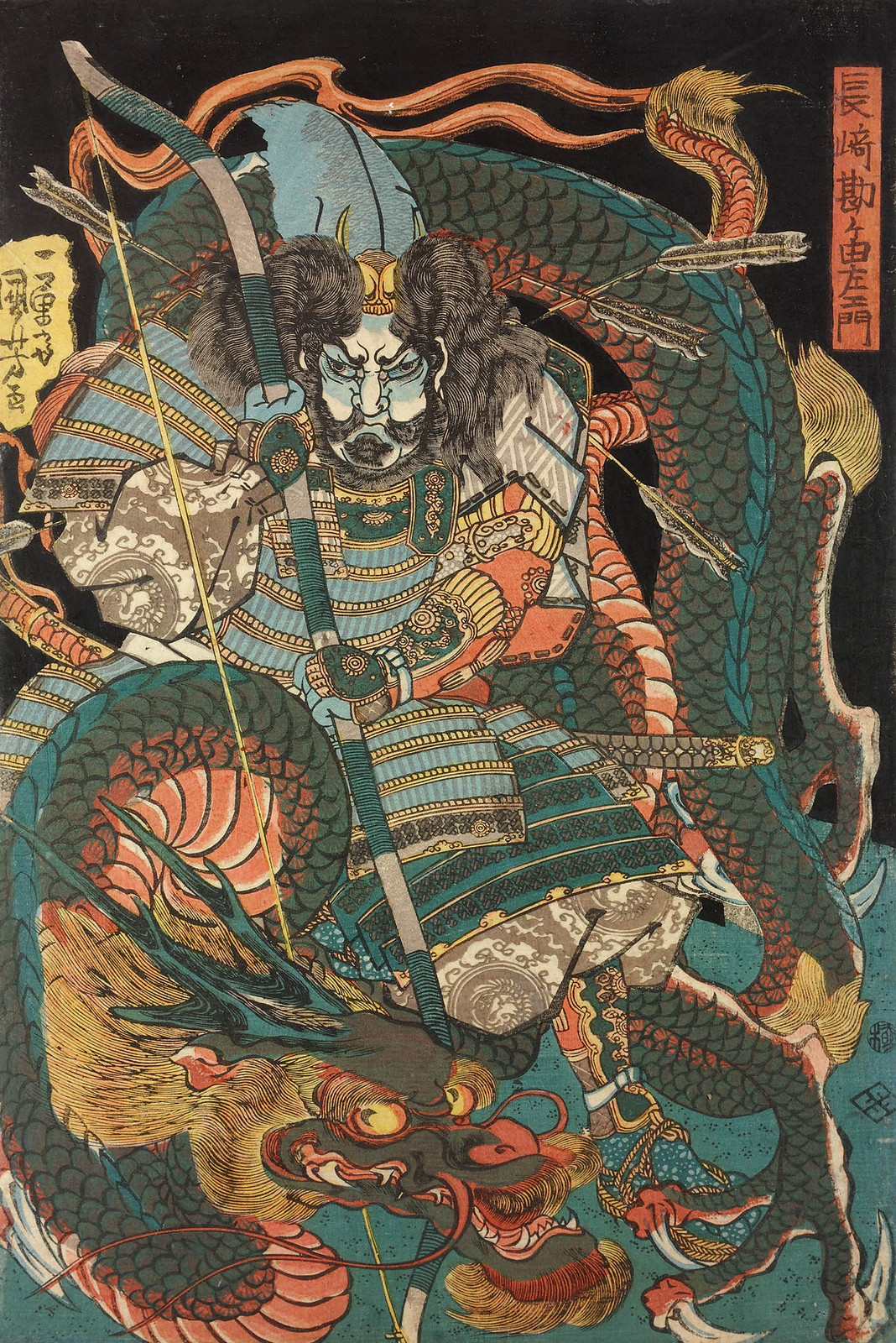 Nagasaki Kangayu-saemon, holding a large bow, riddled with arrows, and enveloped by a dragon. Edo Period
Nagasaki Kangayu-saemon, holding a large bow, riddled with arrows, and enveloped by a dragon. Edo Period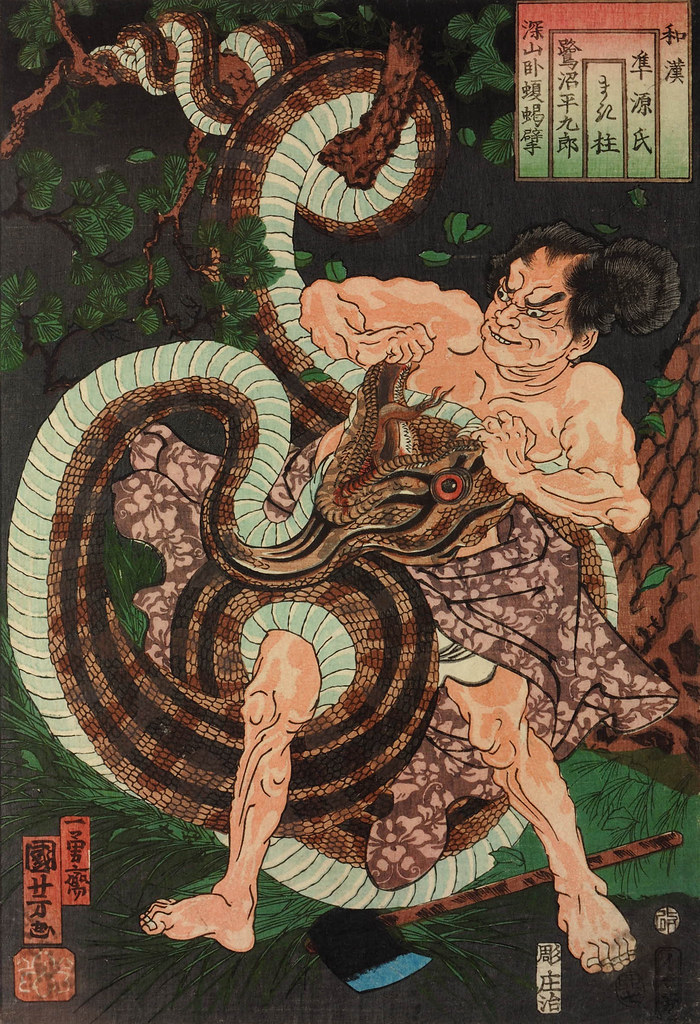 Sagi-no-ike Heikuro, fighting a giant python barehanded in the mountains. 1855
Sagi-no-ike Heikuro, fighting a giant python barehanded in the mountains. 1855 Poem by Ônakatomi no Yoshinobu Ason - Kamiya Niemon, from the series
Ogura Imitations of One Hundred Poems by One Hundred Poets (Ogura
nazorae hyakunin isshu) 1845-48
Poem by Ônakatomi no Yoshinobu Ason - Kamiya Niemon, from the series
Ogura Imitations of One Hundred Poems by One Hundred Poets (Ogura
nazorae hyakunin isshu) 1845-48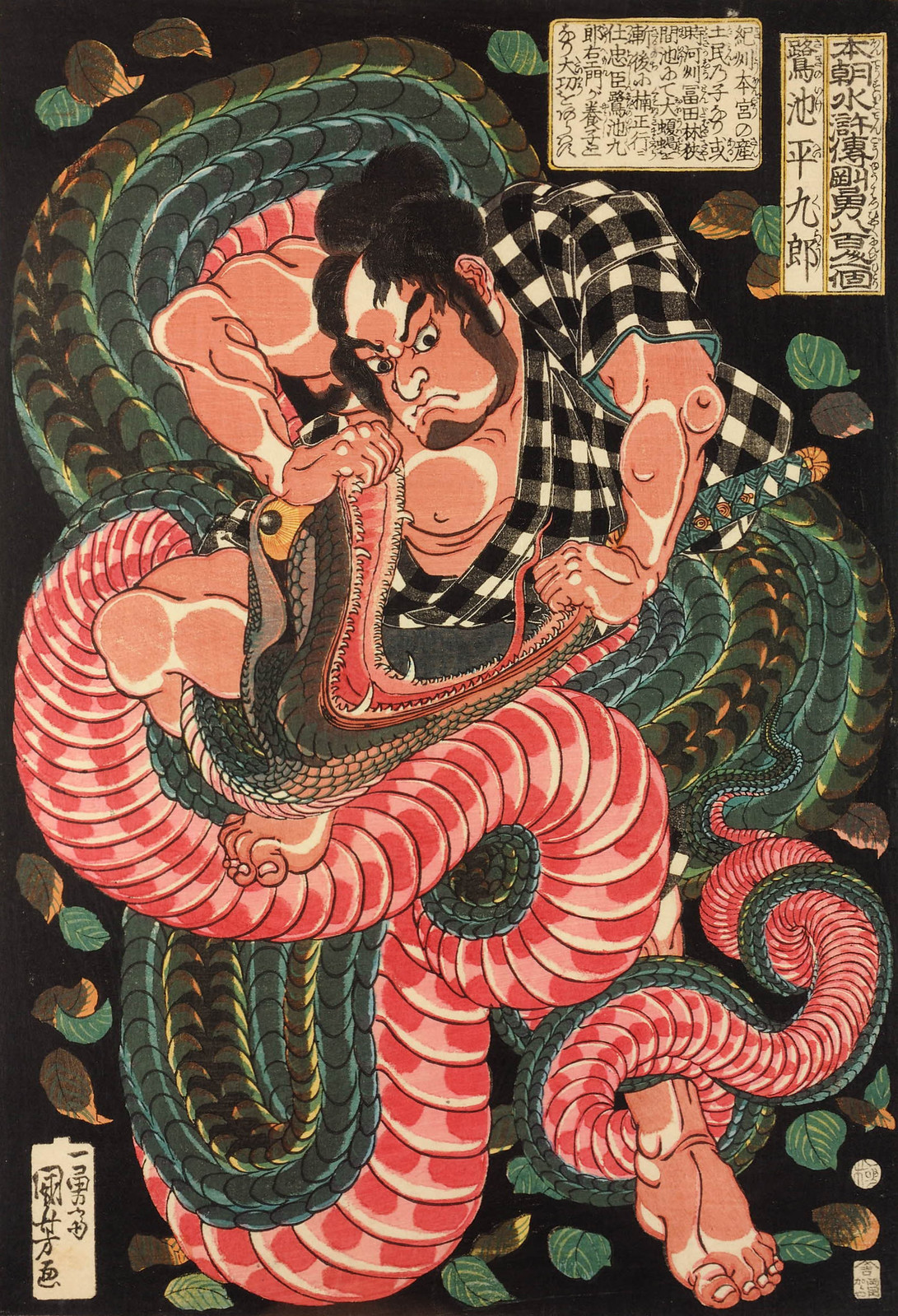 Saginoike Heikuro fights the giant snake at the lake of Sayama. 1830-32
Saginoike Heikuro fights the giant snake at the lake of Sayama. 1830-32 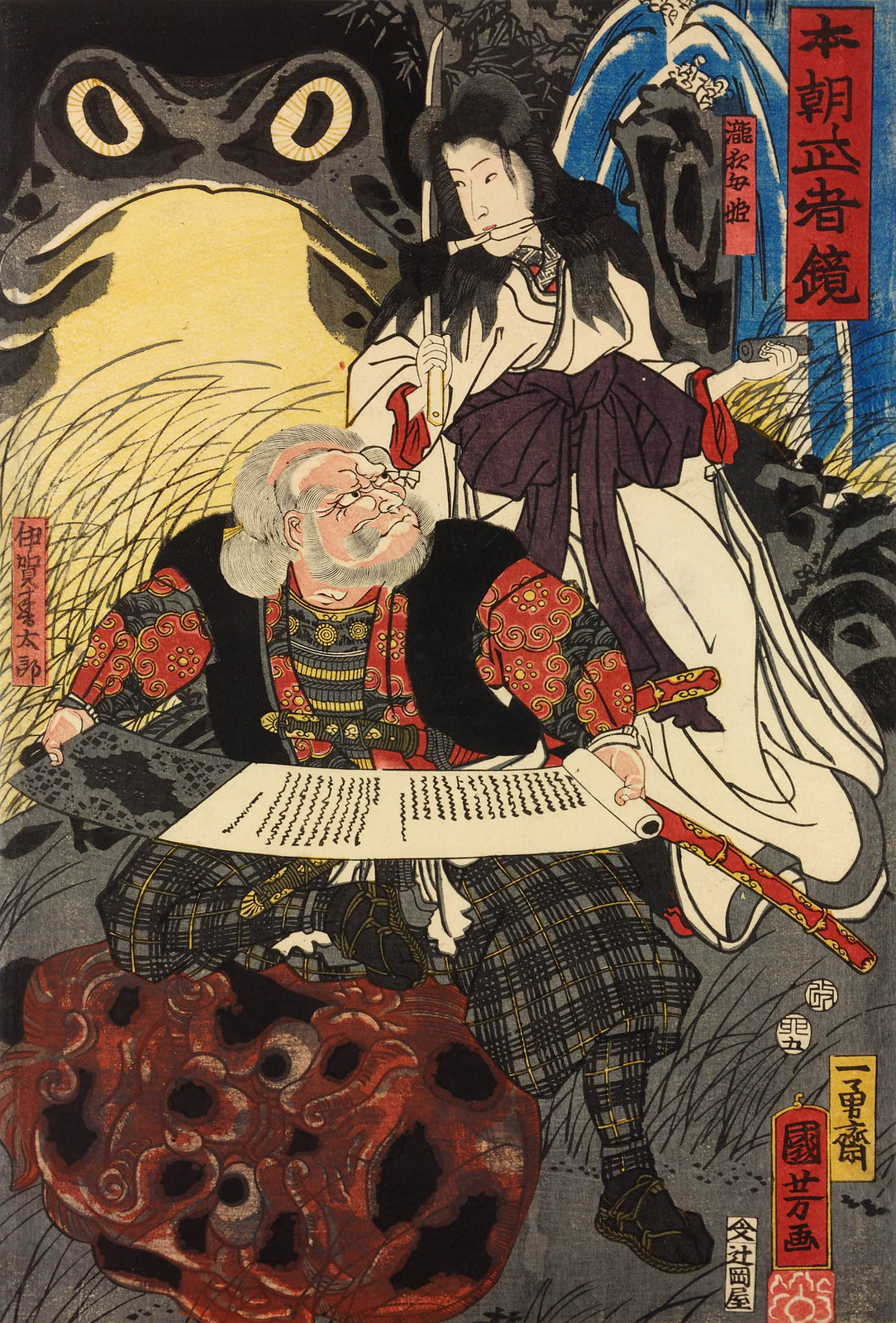 Honcho musha kagami (Mirror of Warriors of Our Country) Iga Jutaro, his
knee on a statue's head, reading a scroll; the witch
Takiyashi-hime, holding a sword, 1855
Honcho musha kagami (Mirror of Warriors of Our Country) Iga Jutaro, his
knee on a statue's head, reading a scroll; the witch
Takiyashi-hime, holding a sword, 1855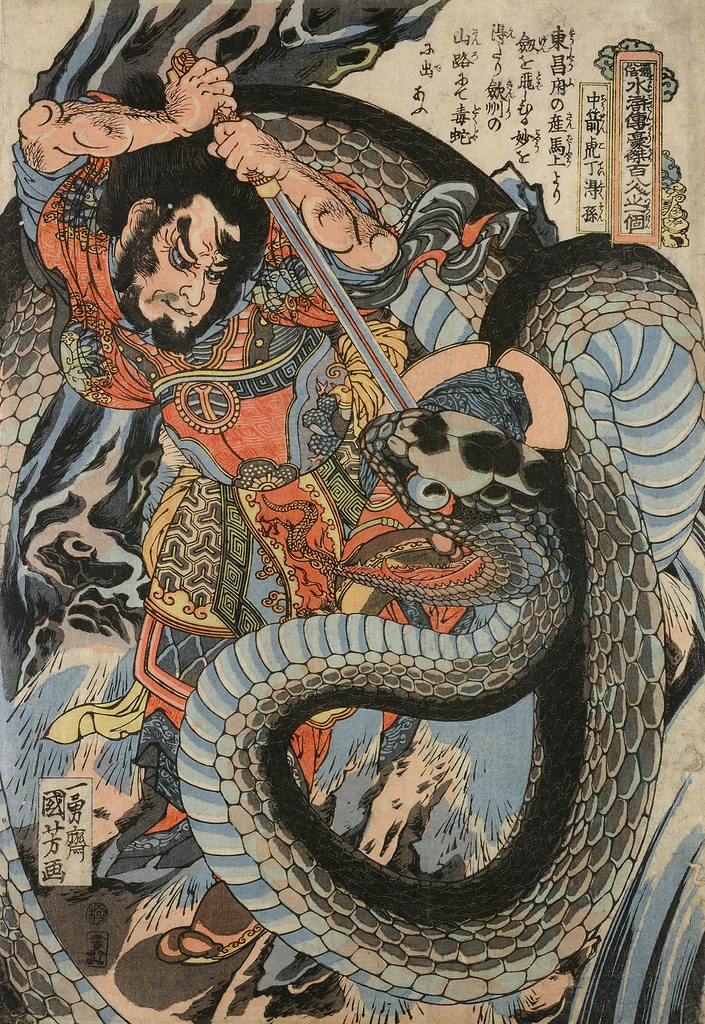 Ding Desun using both hands to drive his sword into an enormous snake, 1827-30
Ding Desun using both hands to drive his sword into an enormous snake, 1827-30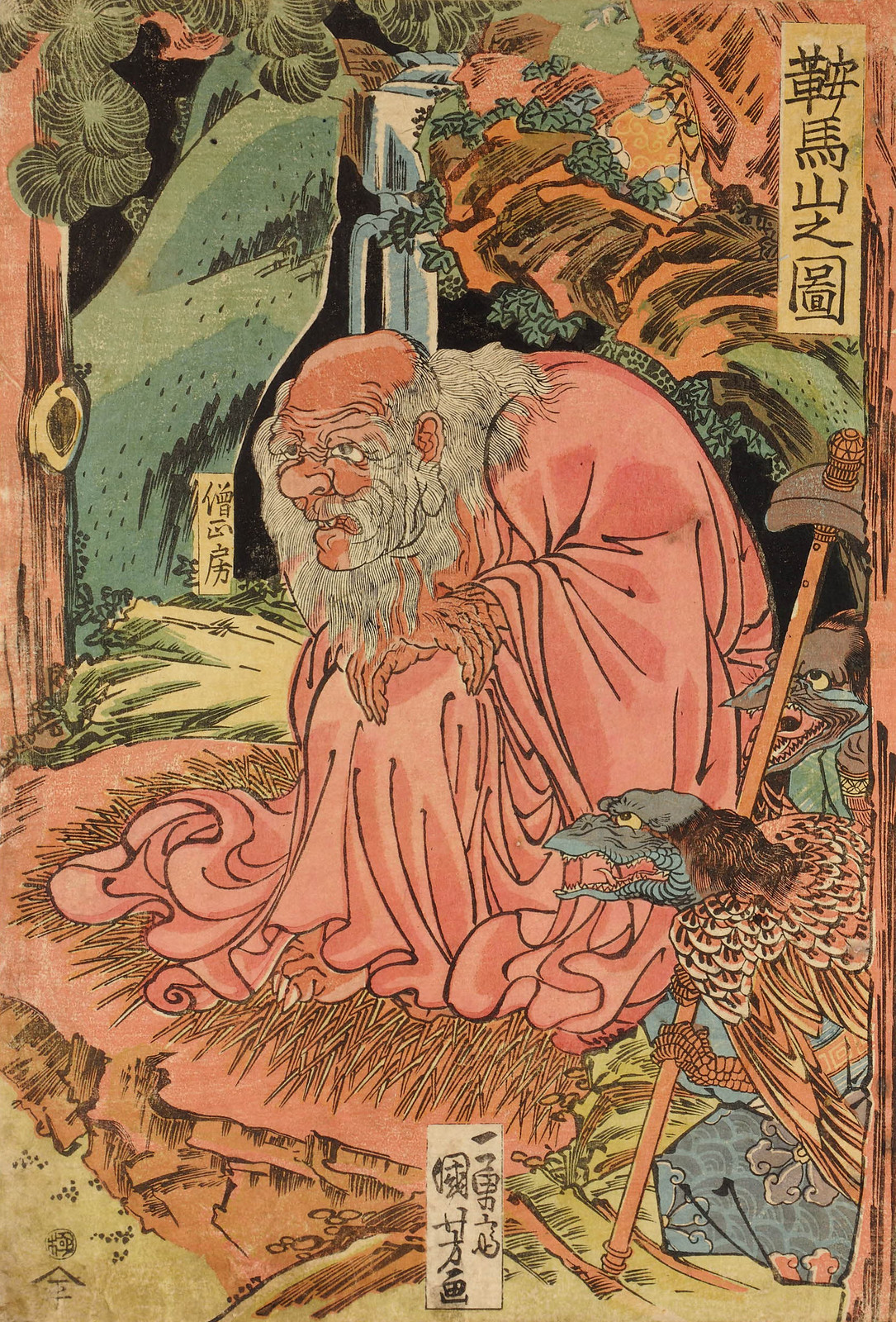 Prince Yoshitsune (Ushiwaka-maru) practising fencing with the tengu
under the direction of their king, Sojo-bo, with Kisanda in attendance,
Edo Period
Prince Yoshitsune (Ushiwaka-maru) practising fencing with the tengu
under the direction of their king, Sojo-bo, with Kisanda in attendance,
Edo Period 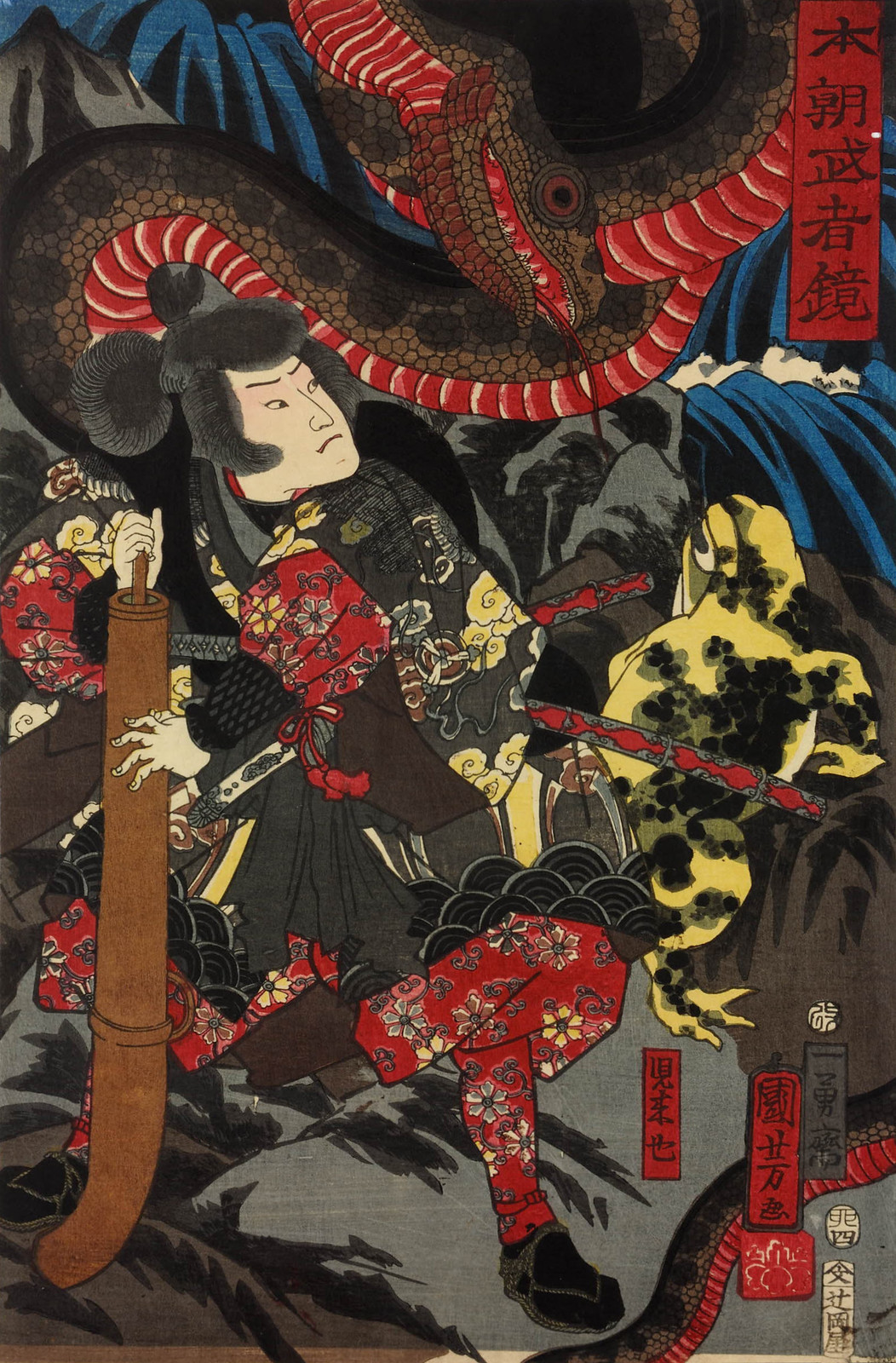 Honcho musha kagami (Mirror of Warriors of Our Country) Jiraiya loading
his gun amongst rocks by a waterfall with a large green and yellow toad,
1855
Honcho musha kagami (Mirror of Warriors of Our Country) Jiraiya loading
his gun amongst rocks by a waterfall with a large green and yellow toad,
1855 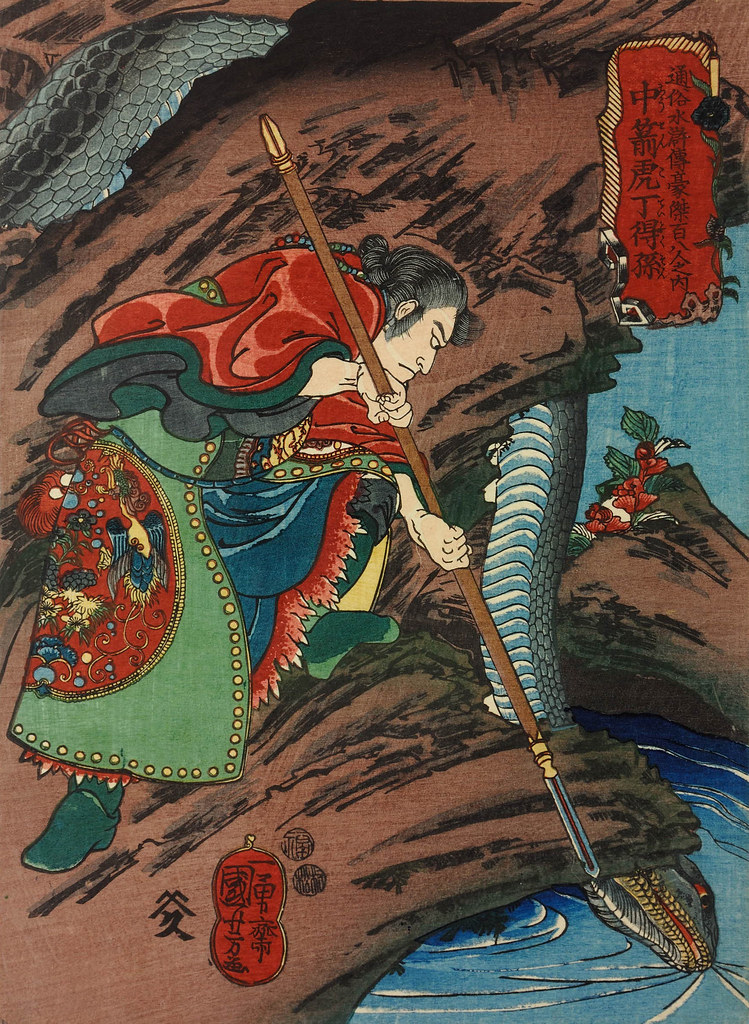 Chusenko Tei Tokuson (Arrow-shot Tiger Ding Desun, 1845-50
Chusenko Tei Tokuson (Arrow-shot Tiger Ding Desun, 1845-50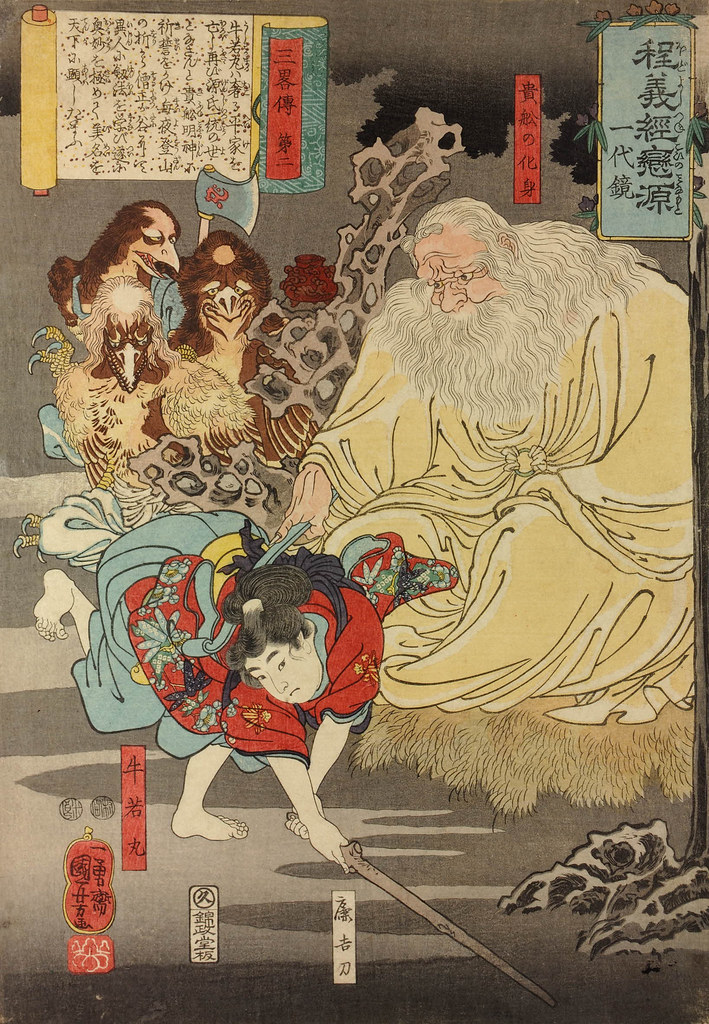 Hodo Yoshitsune koi no Minamoto ichidaigami (Biography of Yoshitsune) 1848-53
Hodo Yoshitsune koi no Minamoto ichidaigami (Biography of Yoshitsune) 1848-53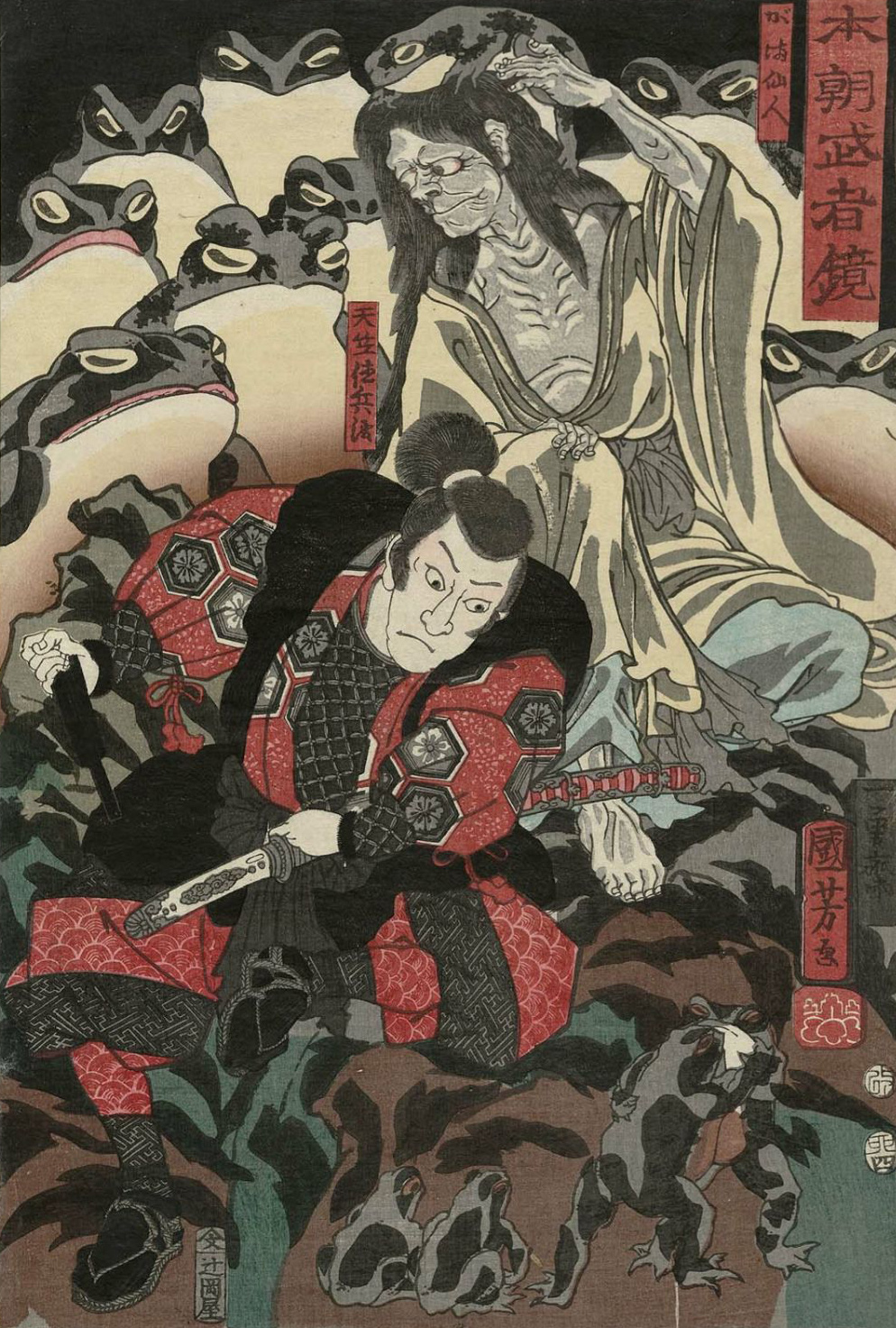 Tenjiku Tokubei and Gama no Sennin, from the series Mirror of Warriors of Our Country (Honchô musha kagami) 1855
Tenjiku Tokubei and Gama no Sennin, from the series Mirror of Warriors of Our Country (Honchô musha kagami) 1855 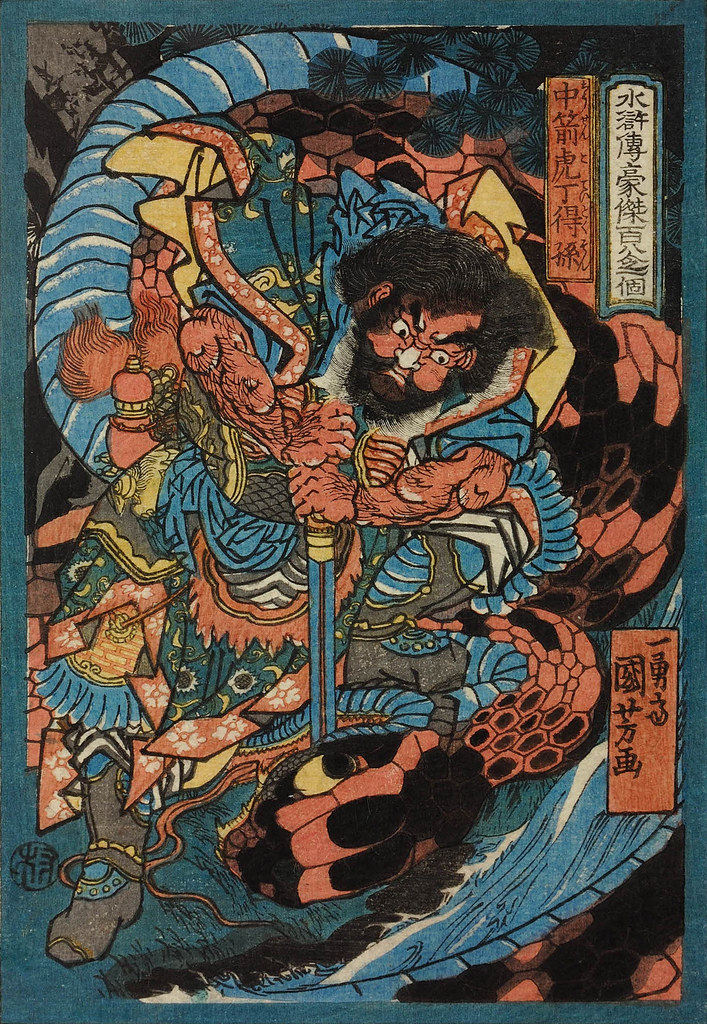 Chusenko Tei Tokuson (Arrow-shot Tiger Ding Desun, 1827-30
Chusenko Tei Tokuson (Arrow-shot Tiger Ding Desun, 1827-30 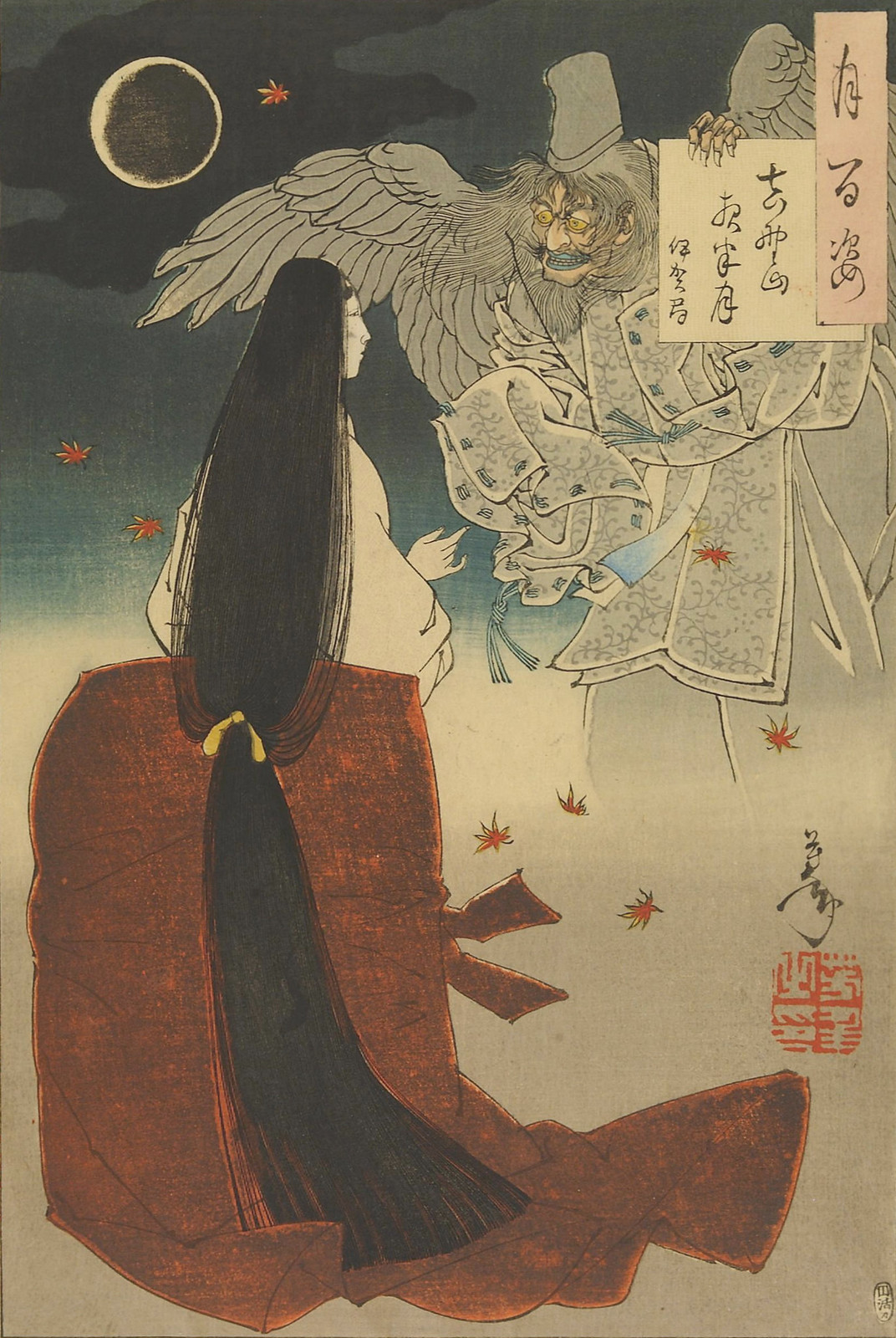 Moonlight over Mount Yoshino, 1886
Moonlight over Mount Yoshino, 1886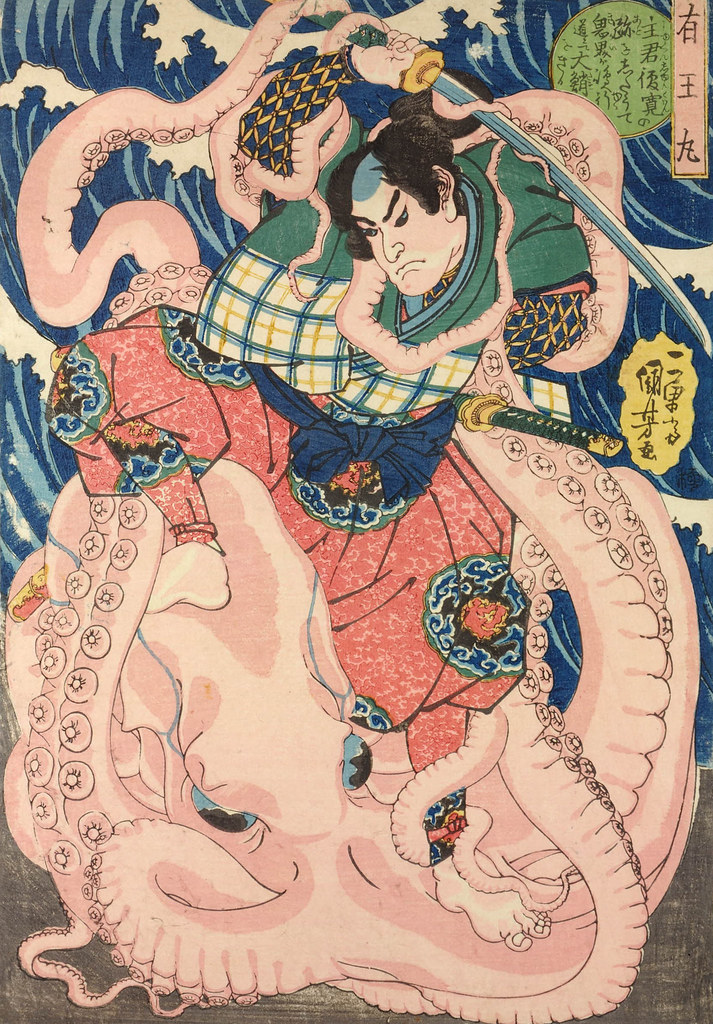 Ario-maru, 1833-35
Ario-maru, 1833-35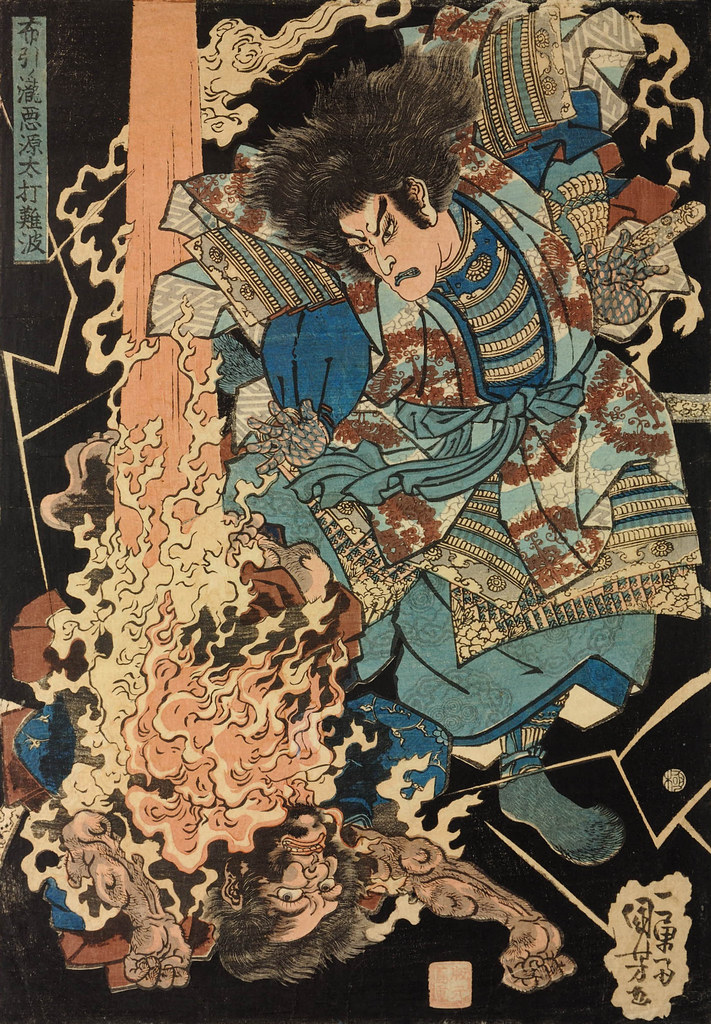 Akugenda Yoshihira, returning as a ghost, executes vengeance with a
thunderbolt on his slayer, Namba Jiro (defeating the source of the
evil). Edo Period
Akugenda Yoshihira, returning as a ghost, executes vengeance with a
thunderbolt on his slayer, Namba Jiro (defeating the source of the
evil). Edo Period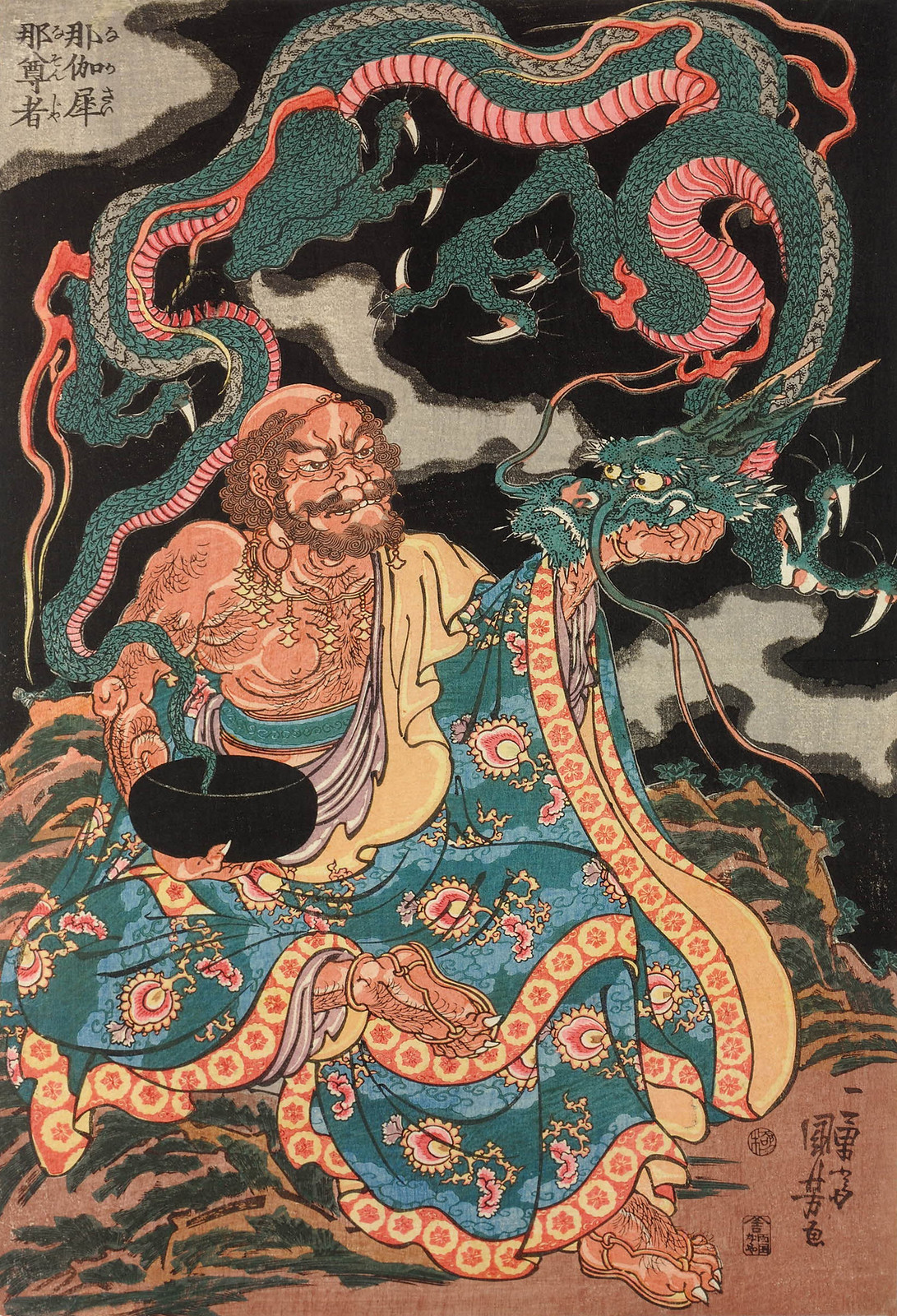 The arhat Nakasaina Sonja seated on a rock, with a dragon emerging from the bowl he holds. Edo Period
The arhat Nakasaina Sonja seated on a rock, with a dragon emerging from the bowl he holds. Edo Period 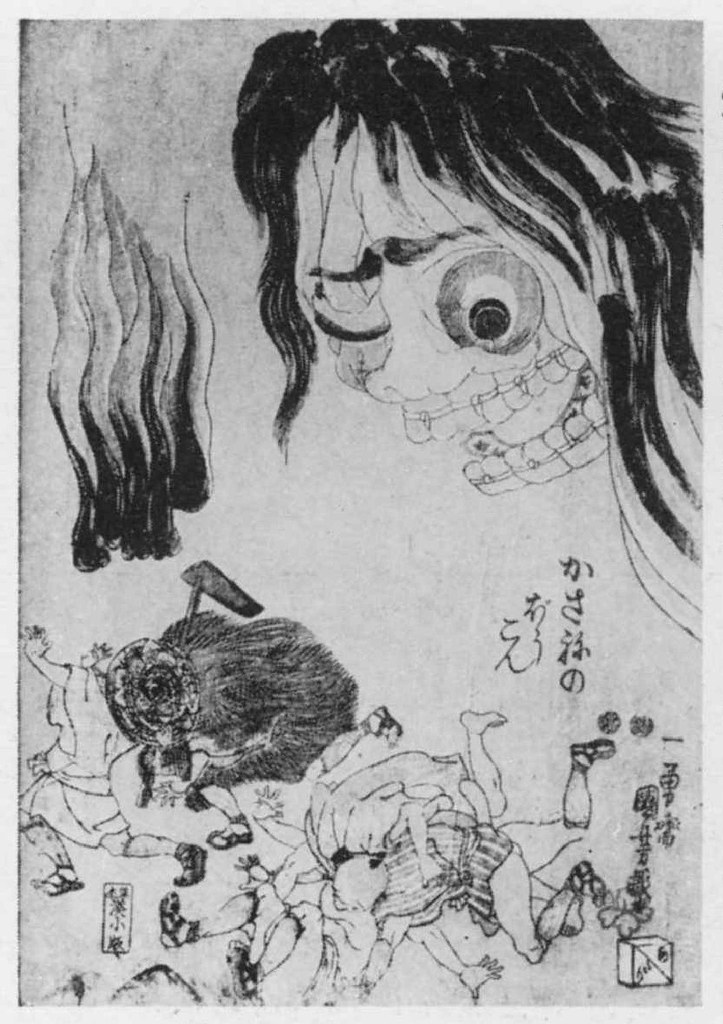 Ghost, 19th C
Ghost, 19th C 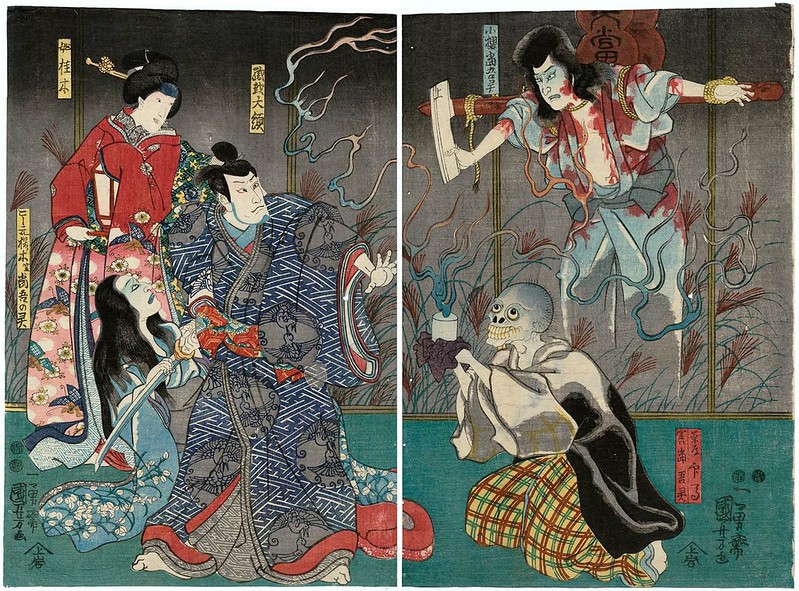 Actors Ichikawa Kodanji IV as the Ghost of Kozakura Tôgô, 1851
Actors Ichikawa Kodanji IV as the Ghost of Kozakura Tôgô, 1851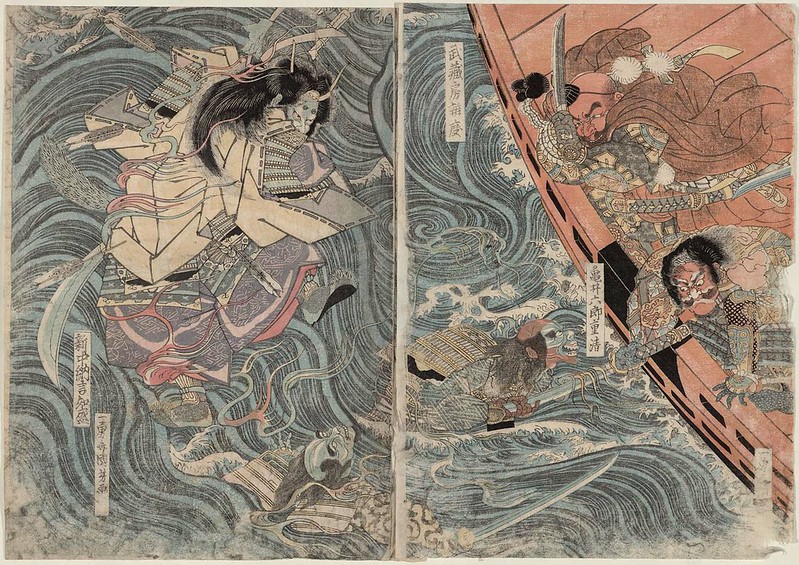 Benkei Fighting the Ghost of Taira Tomomori, 1818
Benkei Fighting the Ghost of Taira Tomomori, 1818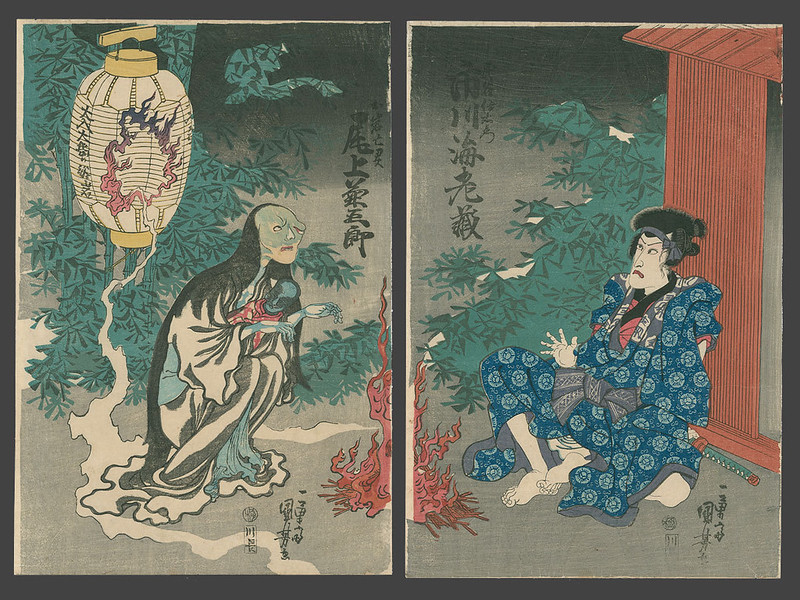 A Scene from the Play "Ghost of Oiwa" (Tokaido Yotsuya Kaidan) 1836
A Scene from the Play "Ghost of Oiwa" (Tokaido Yotsuya Kaidan) 1836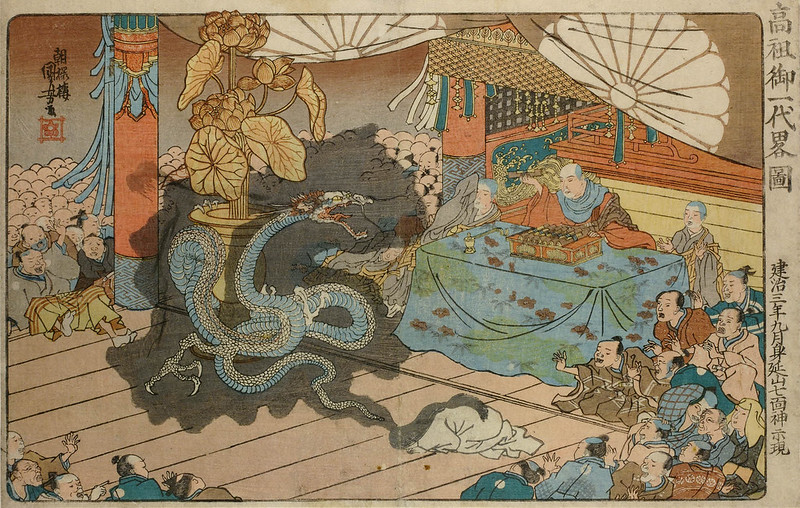 The Apparition of Shichi-menjin at Mt. Minobu in the 9th month of 1277, 19th C
The Apparition of Shichi-menjin at Mt. Minobu in the 9th month of 1277, 19th C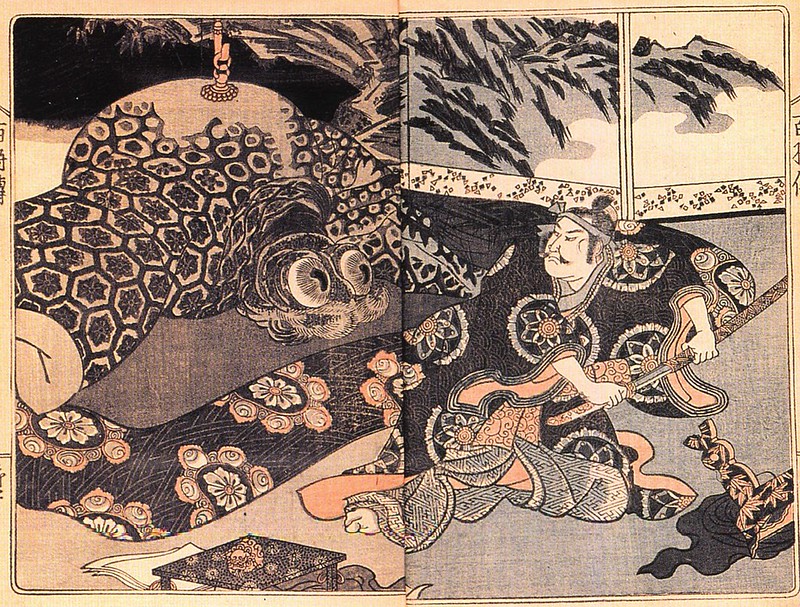 From The Life Of A Hundred Generals, 19th C
From The Life Of A Hundred Generals, 19th C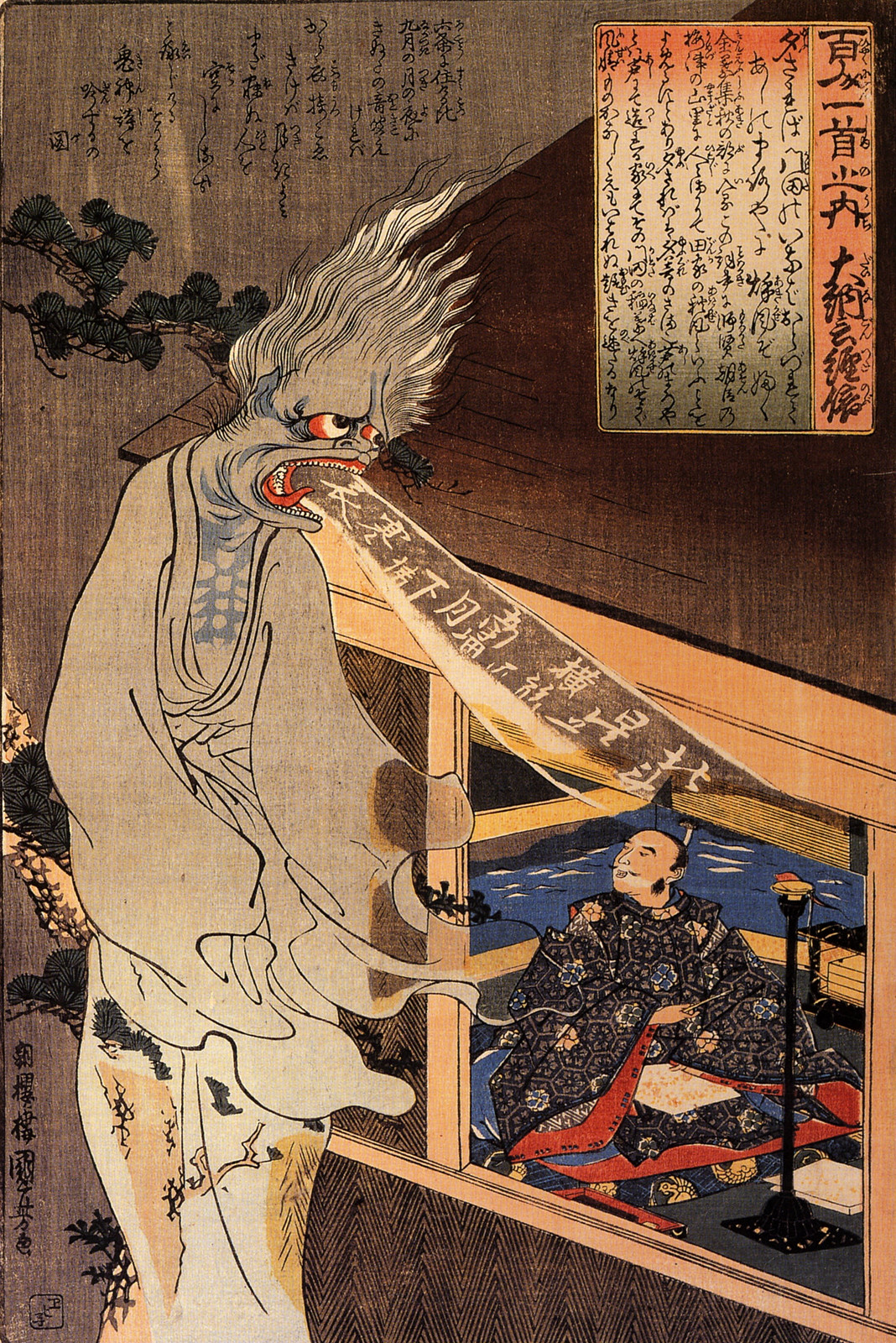 The Poet Dainagon Sees an Apparition, 1860 (version 2)
The Poet Dainagon Sees an Apparition, 1860 (version 2) 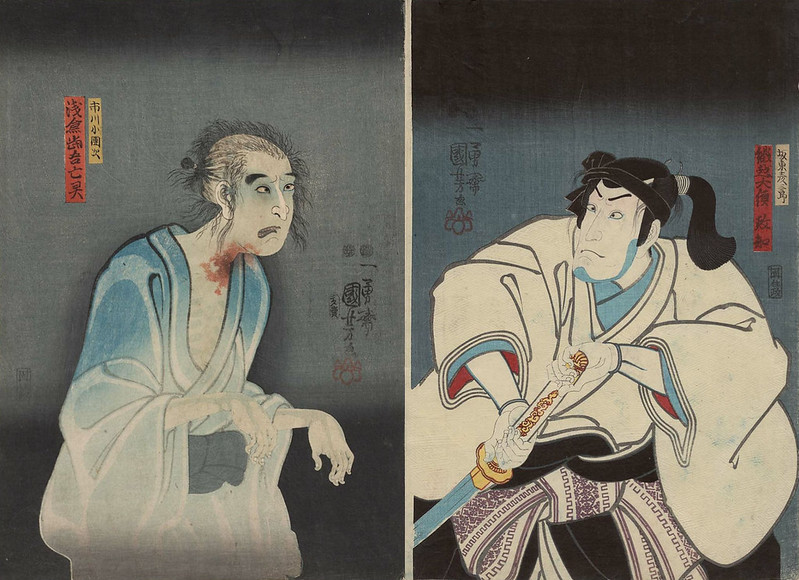 Asakura Togo Borei, 1851
Asakura Togo Borei, 1851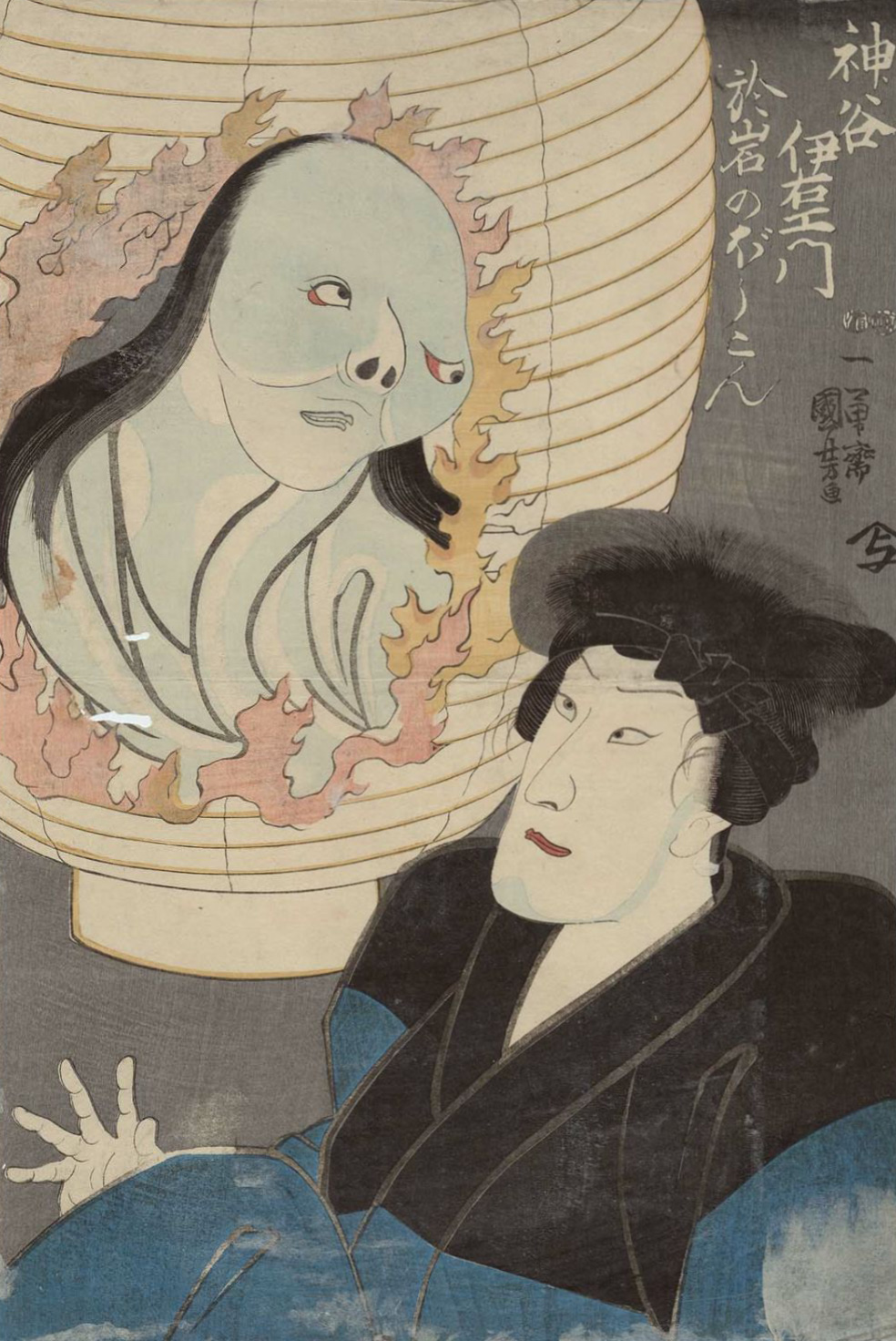 Kamiya Iemon; Oiwa no bokon, 1848
Kamiya Iemon; Oiwa no bokon, 1848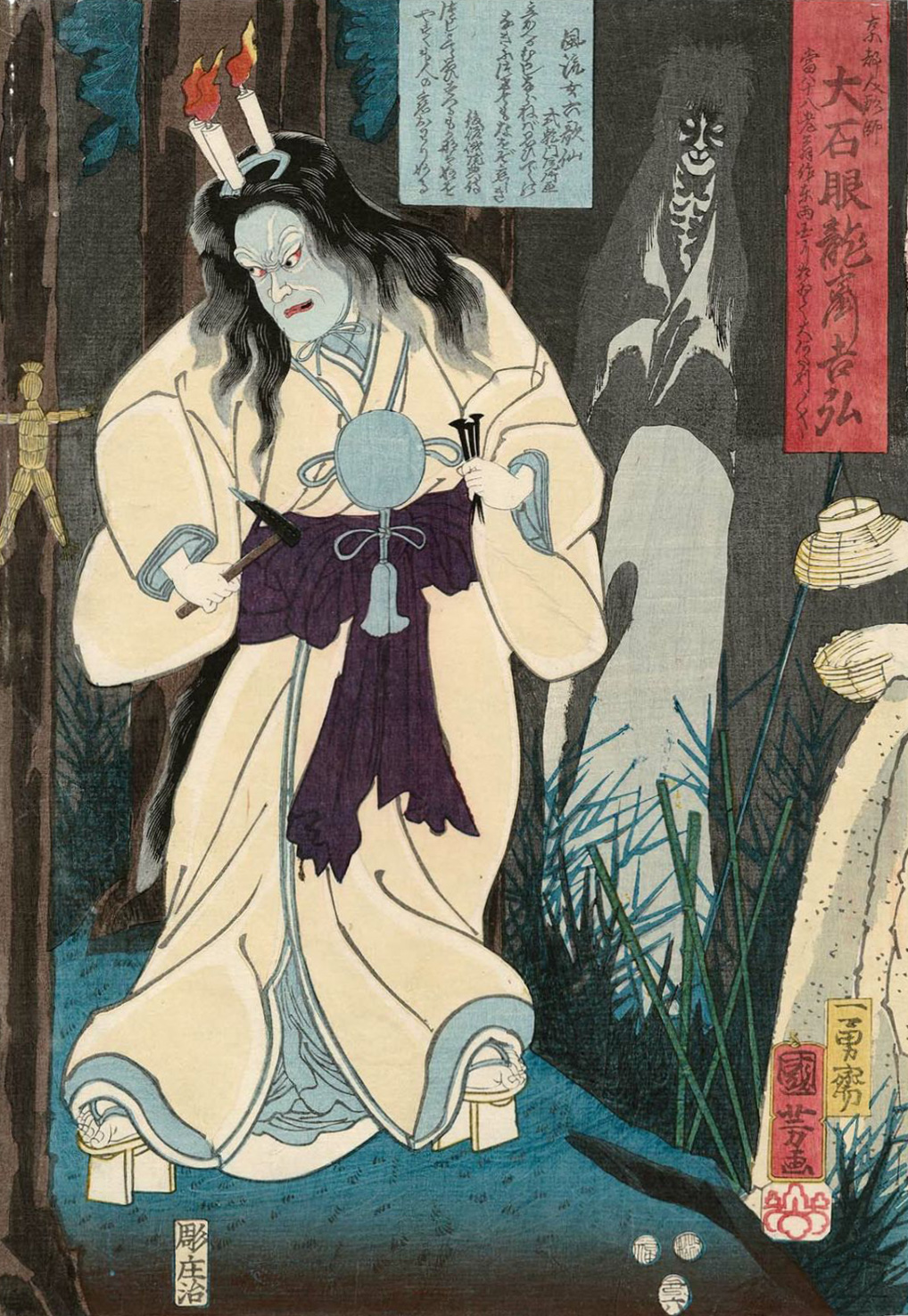 Shrine Visit at the Hour of the Ox, 1853
Shrine Visit at the Hour of the Ox, 1853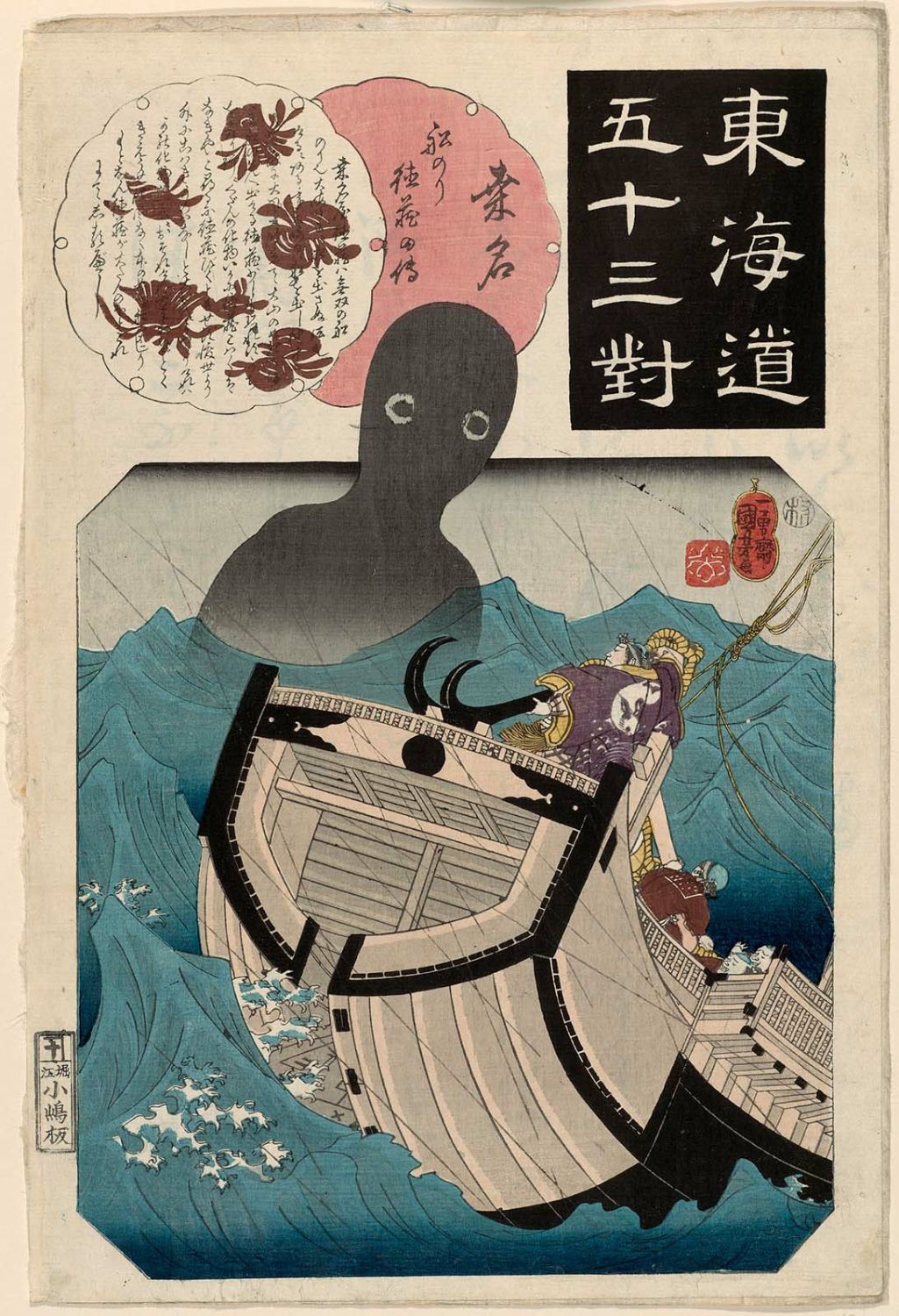 The Story of the Sailor Tokuzô (Funanori Tokuzô no den), from the series Fifty-three Pairings for the Tôkaidô Road, 1845-46
The Story of the Sailor Tokuzô (Funanori Tokuzô no den), from the series Fifty-three Pairings for the Tôkaidô Road, 1845-46
"The vogue for full-body tattoos of interlaced characters, animals and fish, the full arms and backs that writhe with complex figures and designs can be directly traced not only in their drawing but in their conception to the Japanese woodblock artist Utagawa Kuniyoshi. It was he, whilst trying to establish a flagging career in the 1820’s in Edo (Tokyo) Japan, that conceived of decorating heroic, supernatural warriors with florid designs to emphasise their toughness and in some part to elaborate on their narrative.
Kuniyoshi was born Yoshisaburo and like Kunisada was apprenticed to the great woodblock artist Toyokuni I at his Utagawa School 1811. Kuniyoshi showed prodigious talent but unlike his colleague Kunisada failed to find commissions and it was not until the late1820’s that he discovered his own style and overnight success with the release of his series of warrior prints Tūszoku Suikoden gōketsu hyakuhachinin no hitori - The 108 Heroes of the Popular Suikoden (1827). The novelty of these extraordinary, richly embellished and colourful single sheet prints made him successful and went on to heavily influence Japanese fashion and culture.
Kuniyoshi was quick to eclipse his rival Kunisada, at least artistically, and established his own workshop producing some of the finest and most inventive designs in the whole of Japanese art. His was an art of vigour, texture, decoration and mystery. Kuniyoshi not only established the mythological and the warrior print as a major genre, he went on to cover the vogue for portraits of beautiful women, animals, caricature and actor prints. He developed the triptych format of ukiyo print whereby a single element such as a gigantic fish or grappling warriors spill out of one sheet and into the other holding and sometimes bursting out of the cinematic format in distinction to the the previous static use of the form.
Not only one of the finest artists and designers that Japan has produced, Kuniyoshi was also highly intelligent, revelling in the elaborate construction of mitate-e or satire prints where the meaning of the subject is obscured or only alluded to by signs and symbols. This was necessary during the period of severe censorship known as the Tempo Reforms of 1841 - 1843 which halted the production of many woodblock artists." - quote source
More details on the life of Kuniyoshi can be found at Wikipedia.
Sources for the artworks include The Metropolitan Museum of Art, The British Museum and the ukiyo-e archive.
A large selection of Utagawa Kuniyoshi's triptychs can be found in this recent post.

2 comments:
Congrats!
Thanks for exposing me to stuff I never would have seen otherwise.
Epic post!
Post a Comment